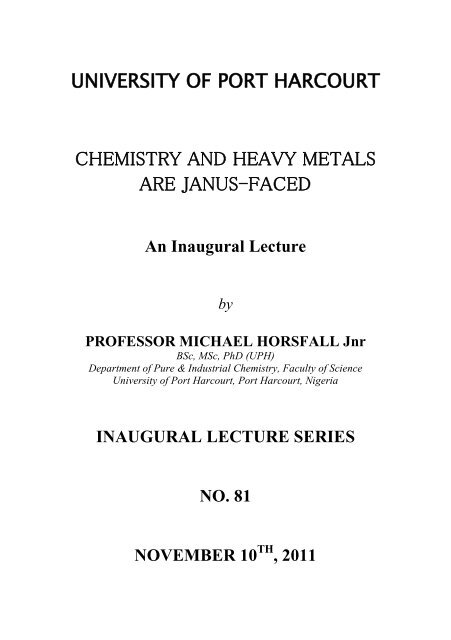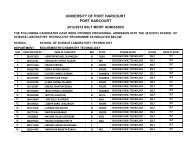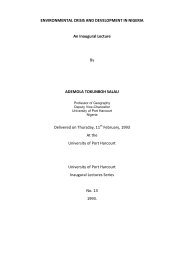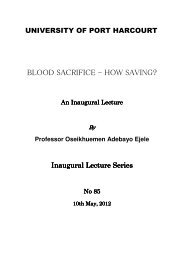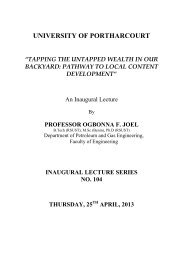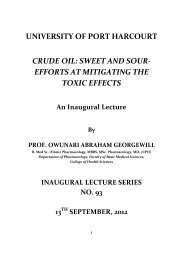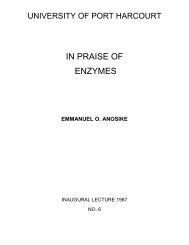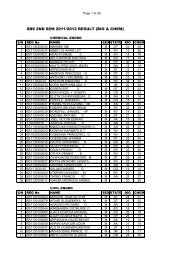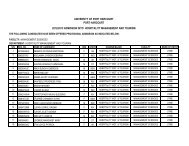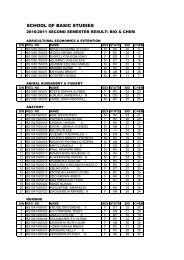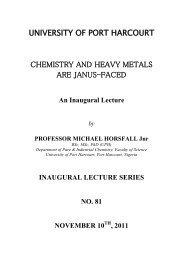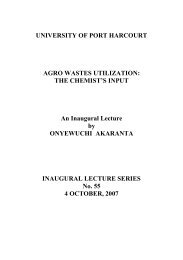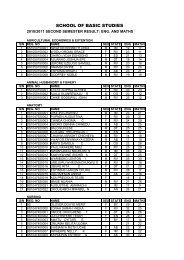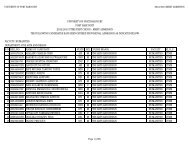An Inaugural Lecture - University of Port Harcourt
An Inaugural Lecture - University of Port Harcourt
An Inaugural Lecture - University of Port Harcourt
Create successful ePaper yourself
Turn your PDF publications into a flip-book with our unique Google optimized e-Paper software.
UNIVERSITY OF PORT HARCOURTCHEMISTRY AND HEAVY METALSARE JANUS-FACED<strong>An</strong> <strong>Inaugural</strong> <strong>Lecture</strong>byPROFESSOR MICHAEL HORSFALL JnrBSc, MSc, PhD (UPH)Department <strong>of</strong> Pure & Industrial Chemistry, Faculty <strong>of</strong> Science<strong>University</strong> <strong>of</strong> <strong>Port</strong> <strong>Harcourt</strong>, <strong>Port</strong> <strong>Harcourt</strong>, NigeriaINAUGURAL LECTURE SERIESNO. 81NOVEMBER 10 TH , 2011
<strong>University</strong> <strong>of</strong> <strong>Port</strong> <strong>Harcourt</strong> Press,<strong>University</strong> <strong>of</strong> <strong>Port</strong> <strong>Harcourt</strong>,<strong>Port</strong> <strong>Harcourt</strong>,Nigeria.Email:upplltd@yahoo.com© MICHAEL HORSFALL JNR 2011ISSN: 1119-9849INAUGURAL LECTURE SERIES No. 81DELIVERED: 10 November, 2011All Rights ReservedDesigned, Printed and Bound by UPPLii
DEDICATIONThis inaugural <strong>Lecture</strong> is dedicatedto theBlessed Memory<strong>of</strong> my late ParentsPastor Michael HorsfallandMrs. Norah Horsfalliii
ACKNOWLEDGEMENTBefore I start this lecture, I wish to appreciate the AlmightyGod for this moment in my life. Thank you, my HeavenlyFather, Thank you, my Lord Jesus, Thank you, my dear HolyGhost for all that you have done and continue to do in my life.I would like to express my gratitude to a number <strong>of</strong> people. Myjourney started with my parents, especially my mother who hasnever sat in a classroom but has a strong faith and desire forschool. I would like my late parents; Pastor and Mrs. MichaelHorsfall to share this moment <strong>of</strong> joy with me in the fullknowledge that they have been part <strong>of</strong> this from the beginning,I say from the bottom <strong>of</strong> my heart, thank you.I would like to thank my senior brother Mr Ibinabo MichaelHorsfall, who has not only been an inspiration to me from avery young age, but has supported me in ways I cannotenumerate; Mine-Bro, thanks a million.I would like to express my gratitude to my family members,friends, colleagues and associates, some <strong>of</strong> whom are MrPeaceman Batubo, Hon. Abiye M. Horsfall, Hon. E. O.Dakoru, Mr. Somieari D. Wokoma, Dr. Leo Osuji, Dr. P.Jackreece, Dr. D. Wankasi, Dr. O. Abiola, Dr. T. Tarawou,Pr<strong>of</strong>. T. Akphorhonor, Dr. I. C. Howard, Mr Fatai Aborode,Dr. B. S. Kinigoma, Mr. I. Princewill, Dr (Mrs). K. Orubite,Dr. M. Iwegbue, Dr. Eva Krupp, Mr. Ken Omaye, Late Mr &Mrs A. J. Jenewari, Rev. B. P. Adowei, and a host <strong>of</strong> othersPere, mon cherie, I say thank you. Otis, Doris, Evita, Laveta,Oscar, David and Elvin, I love you all.iv
There are many people who have influenced my life as achemist, too many to list here; they are my lecturers. Some <strong>of</strong>them are Pr<strong>of</strong>. Oladele Osibanjo, Pr<strong>of</strong>. A. C. I. <strong>An</strong>usiem andPr<strong>of</strong>. (Mrs) P. Manilla (my BSc project supervisors), Pr<strong>of</strong>. C.M. Ojinnaka (my MSc project supervisor), Pr<strong>of</strong>. Ayebaemi I.Spiff and late Dr. Fred E. Ogban (my PhD project supervisors),Pr<strong>of</strong>. A. A. Abia and late Dr. Ph Dah (my advisers) and Pr<strong>of</strong>Bene Willey-Abbey (my encourager). I cannot think <strong>of</strong> abetter way to show them honour and respect than to say thankyou.Nobody comes this far without the hard work <strong>of</strong> graduatestudents, who, in spite <strong>of</strong> limited facilities, have madeexcellent contributions to my research. To those <strong>of</strong> you hereand those who couldn’t be here, I thank you.Finally, I wish to acknowledge my numerous collaboratorsboth home and abroad. In no chronological order at theinternational arena are Pr<strong>of</strong>. (Dr.) J. D. Lee and Dr. TonyEdmonds, Loughborough <strong>University</strong>, UK, Pr<strong>of</strong>. (Dr.) JoseVicente, <strong>University</strong> <strong>of</strong> La Plata, Argentina, Pr<strong>of</strong>. JorgFeldman, <strong>University</strong> <strong>of</strong> Aberdeen, Scotland; Dr. MohammadCourti, <strong>University</strong> <strong>of</strong> Zimbabwe, Harare, The Third WorldAcademy <strong>of</strong> Sciences (TWAS) Italy; National ResearchCouncil (CONICET) <strong>of</strong> Argentina; UNESCO <strong>of</strong>fice, Kenya,Royal Society <strong>of</strong> Chemistry, UK, Organization <strong>of</strong> Prohibition<strong>of</strong> Chemical Weapons (OPWC) The Hague, Trace ElementSpeciation Laboratory (TESLA) Research Group members.In the national arena are the <strong>University</strong> <strong>of</strong> <strong>Port</strong> <strong>Harcourt</strong>, theWorld Bank Office at NUC – Abuja, Nigeria; NationalAgricultural Research Project (NARP) Team led by Pr<strong>of</strong>. F. D.Sikoki, the River State Government, Fugro Nigeria Ltd headedby Dr. G. C. Ofunne, and finally Pr<strong>of</strong>. (Barr.) Bio. L.v
Nyananyo who despite the wide difference in academicexperience accepted to be my orator. I was humbled; I saythank you sir.I wish to end this acknowledgement by giving a special thanksto the former Director <strong>of</strong> the Institute <strong>of</strong> Petroleum Studies(IPS), Pr<strong>of</strong>. A. J. Ajienka (now Vice Chancellor) forencouraging and supporting the Journal <strong>of</strong> Applied Sciencesand Environmental Management (JASEM), while he was atIPS.vi
CHEMISTRY AND HEAVY METALS ARE JANUS-FACEDVice-Chancellor,Member(s) <strong>of</strong> the <strong>University</strong> Council present,Deputy Vice-Chancellors,Registrar and other Principal Officers,Provost, College <strong>of</strong> Health Sciences,Dean, School <strong>of</strong> Graduate Studies,Deans <strong>of</strong> Faculties,Heads <strong>of</strong> Administrative and Academic Departments,Other <strong>University</strong> Colleagues,Distinguished guests,Students,Friends,Members <strong>of</strong> my family and relatives,Ladies and Gentlemenvii
PREAMBLEDear Vice-Chancellor, at the very onset, let me thank GodAlmighty for sustaining me all these years to present thispr<strong>of</strong>essorial lecture. Without God’s love, I would not havebecome eligible to stand here today.I wish to thank the incubent Vice Chancellor for this honourand opportunity <strong>of</strong> presenting my inaugural lecture.I also wish to express a special gratitude to my Big Mummy,Pr<strong>of</strong>essor (Mrs.) Ayebaemi Ibuteme Spiff who consistentlyencouraged me to deliver an inaugural lecture as soon as myPr<strong>of</strong>essorial assessments are concluded.Immediately the Pr<strong>of</strong>essorial assessments were over, Isearched various sources to find what a Pr<strong>of</strong>essorial <strong>Inaugural</strong>lecture is supposed to be. In the process I came across a lot <strong>of</strong>very enlightening information, but the one I liked most is fromthe website <strong>of</strong> <strong>University</strong> <strong>of</strong> Edinburgh. I have quoted it hereto show you what has guided me in preparing this lecture:“The <strong>Inaugural</strong> <strong>Lecture</strong> is an opportunity for newly-promotedor appointed Pr<strong>of</strong>essors to inform colleagues in the <strong>University</strong>and the general public, about their research career so far; andupdate colleagues on their current and future researchdirections. The lecture is intended to emphasize both thesignificance <strong>of</strong> research and its implications for the discipline.Moreover, the inaugural lecture is a public event and shouldbe designed both in its title and its scope to be accessible tointerested members <strong>of</strong> the public”.viii
With this in mind, I spent several days imagining <strong>of</strong> what Ithought would be an appropriate title for this lecture. Then, Iremembered my early contact with chemistry in Class 3 <strong>of</strong> mysecondary school days.The first Chemistry teacher told us that “Chemistry iscorrosive, so beware <strong>of</strong> chemists”; a second chemistry teacherlater said to us “A world without chemistry would be a worldwithout cinema, a world without aspirin or soap, or paper; ifyou want to understand chemistry, you must first lovechemistry”. At this point several things went through mymind, the rest is history but I said to myself this is doublestandard.<strong>An</strong>other incident was during my PhD research work; whichwas titled “Heavy Metal Pollution: the impact <strong>of</strong> industrialactivities on the baseline levels in the New Calabar River,Nigeria”.In the process <strong>of</strong> that research, I came to know that “in smallamount, heavy metals are essential to maintain the metabolism<strong>of</strong> the human body”; however, “at higher concentrations theycan lead to poisoning”. <strong>An</strong>other double standard.I then searched everywhere to capture a word that can bestdescribe two opposing sides or two different opinions for asingle entity; and that was Janus.Dear Vice Chancellor, because <strong>of</strong> the twin-opposite incidenceduring my early contact with chemistry and heavy metals, Ihave titled my inaugural lecture today as “Chemistry andHeavy Metals are Janus-Faced”ix
INTRODUCTIONIn ancient Roman religion, Janus [Varo, 1449] is the god <strong>of</strong>beginnings and transitions. Janus is <strong>of</strong>ten depicted as havingtwo heads, facing opposite directions, symbolically lookingsimultaneously into the past and the future (Fig 1).Fig.1: A statue representing Janus.Chemistry is Janus-FacedI have therefore described the science <strong>of</strong> chemistry as Janusfaced.One face embodies the countless services it provides formankind; the other, pollution and industrial disasters.One Face <strong>of</strong> ChemistryChemistry is the science <strong>of</strong> matter and the changes that mattercan undergo.In the broadest possible terms, chemists take one form <strong>of</strong>matter and conjure from it a different form. In many cases,they take more sophisticated forms <strong>of</strong> matter and convert itinto materials suitable for use or to substances needed for hightechnology.1
Take water, for instance, the absolute essential enabler <strong>of</strong> life.Chemistry has made communal living possible by purifyingwater to remove pathogens by a process called chlorination[Darnell, 1911].As the global population grows and the productive land area iseroded, so it becomes more and more important to coax cropsinto greater abundance. The traditional way to encourageabundance is to apply fertilizers. Chemists harvested the skies,taking the nitrogen <strong>of</strong> the atmosphere and converting it int<strong>of</strong>ertilizer and ensuring that these can be assimilated by plants.After water and food, we need energy. Nothing happens in theworld without energy. Civilizations would collapse if it ceasesto be available.Chemists contribute at all levels and to all aspects, <strong>of</strong>developing both new sources and more efficient applications<strong>of</strong> current sources <strong>of</strong> energy. Petroleum is one <strong>of</strong> the legacies<strong>of</strong> the past, being the partially decomposed residue <strong>of</strong> organicmatter, that sank to the bottom <strong>of</strong> lakes and seas and was latersubjected to heat and pressure. Chemists have long contributedto the refinement <strong>of</strong> crude oil into various useable fractions.Where do chemists currently look for new sources <strong>of</strong> energy?The Sun. Chemists have already developed moderatelyefficient photovoltaic materials to capture energy from the sun.Chemists are designers; Look at plants – their leaves are greenbecause <strong>of</strong> chlorophyll. Blood is red because <strong>of</strong> haemoglobin.Those molecules are actually almost the same, except the onein leaves has magnesium (Mg) in the centre; the one in bloodhas iron (Fe) in the centre.2
Structure <strong>of</strong> Chlorophyll 1cStructure <strong>of</strong> HemoglobinFig. 2: Structures <strong>of</strong> Chlorophyll and HemoglobinChemists can change the molecule at the centre <strong>of</strong> leaves witha different metal and produce a dye which can be used incolouring jeans.Plastics are but one face <strong>of</strong> the materials revolution [Fenichel,1996] that has characterized the last one hundred years and iscontinuing vigorously today, chemists were the brains behindit.Chemists developed the semiconductors that lie at the heart <strong>of</strong>computation and the optical fibres that are increasinglyreplacing copper for the transmission <strong>of</strong> signals [Sariciftci, etal 1992].One <strong>of</strong> the great contributions <strong>of</strong> chemistry to humancivilization has been the development <strong>of</strong> pharmaceuticals[McGuire et al 2007]. Chemists can be justly proud <strong>of</strong> theircontribution to the development <strong>of</strong> chemical agents againstdiseases.Chemistry also contributes to the understanding <strong>of</strong>nanotechnology, biotechnology, medicine, engineering, andseveral other challenging scientific endeavours.3
Chemists have already helped to produce the mobile sources,such as laptops, telephones, vehicles and monitoring devices <strong>of</strong>all kinds and the batteries, which drives them.The benefits <strong>of</strong> chemistry research can be appreciated if wetake a close look at the components <strong>of</strong> a mobile phone (Fig 2).Fig. 3: The Benefits <strong>of</strong> Chemistry ResearchThe components <strong>of</strong> a mobile phone are:1. Bag: LDPE (low density polyethylene)2. CD-ROM Sleeve: Polycarbonate acrylic, paper, LDPE, metal3. Manual: paper4. Keys: Polypropylene5. Circuit Board: Fibre-glass epoxy composite, metals,ceramics6. Charger: acrylonitrile-butadiene-styrene polycarbonatehousing, PVC coated copper wire, metal conductor,ceramics7. Housing case: acrylonitrile butadiene-styrene polycarbonate8. Data Cable: PVC coated copper wire, metal connectors, and9. Box: card board interior; moulded polystyrene4
The Other Face <strong>of</strong> ChemistryAt the same time, however, no other science is connected withmore bad emotions and anxiety across wide sectors <strong>of</strong> societythan chemistry. The achievements in Chemistry have come at aprice: our collective human health and the global environmentare threatened. Our bodies are contaminated with a largenumber <strong>of</strong> synthetic industrial chemicals, many <strong>of</strong> which areknown to be toxic and carcinogenic. Some dangers <strong>of</strong>chemistry research include industrial emissions leading to fishkills, air pollution and oil pollution (Fig 4).BACDFig. 4: Some Dangers <strong>of</strong> Chemistry researchIn some dreadful cases, accidents have killed and maimedthousands. The explosion at the Union Carbide plant in Bhopalin India in 1984 [Weisman, 1985], the Minnamata [George,2001] and Itai-itai [Almeida Stearns, 1998] diseases due to5
mercury and cadmium pollution in Japan between 1912 and1968, several major and minor incidents <strong>of</strong> oil disasters in theNiger Delta region between 1960 to 2011; and the recent majoroil disaster in the Gulf <strong>of</strong> Mexico in 2010 are also worthy to bementioned.These disadvantages and horrors have also made me to believethat chemistry is corrosive.Heavy Metals are Janus-FacedI have also described the science <strong>of</strong> heavy metals as Janusfaced.One face embodies the essentiality <strong>of</strong> heavy metals; andthe other, pollution and toxicity.Metals occupy the bulk <strong>of</strong> the periodic table <strong>of</strong> elements. Themost current periodic table (Table 1) contains 118 elements, <strong>of</strong>which 18 are non-metals, 10 are metalloids and 90 are metals.Out <strong>of</strong> the 90 metals, 35 metals are <strong>of</strong> concern to us because <strong>of</strong>occupational or residential exposure; 23 <strong>of</strong> these are describedas the heavy metals [Daffus, 2002].Fig. 5A: The Most recent Periodic Table <strong>of</strong> Elements6
Fig 5B: Skeletal periodic arrangement for the elements showing metals,non-metals and metalloidsMany different definitions have been proposed for heavymetals —some based on density, some on atomic number oratomic weight, and some on chemical properties or toxicity[Daffus, 2002].In this inaugural lecture, I have defined heavy metalsfollowing Lide (1992) as a subset <strong>of</strong> chemical elements with aspecific gravity that is at least 5 times the specific gravity <strong>of</strong>water. This definition includes metals and methalloids.The heavy metals include antimony, arsenic, bismuth,cadmium, cerium, chromium, cobalt, copper, gallium, gold,iron, lead, manganese, mercury, nickel, platinum, silver,tellurium, thallium, tin, uranium, vanadium, and zinc [Glanze,1996].7
One Face <strong>of</strong> Heavy MetalsIn small quantities, certain heavy metals are nutritionallyessential for a healthy life. These elements, or some form <strong>of</strong>them, are commonly found naturally in foodstuffs, in fruits andvegetables, and in commercially available multivitaminproducts [IOSHIC, 1999].Some are used in diagnostic medical applications such asdirect injection <strong>of</strong> gallium during radiological procedures, theuse <strong>of</strong> lead as a radiation shield around x-ray equipment andthe use <strong>of</strong> silver and mercury amalgam for tooth filling[Roberts 1999].Essential heavy metals also have normal physiologicalregulatory functions. Heavy metals are also common inindustrial applications such as in the manufacture <strong>of</strong> pesticides,batteries, alloys, electroplated metal parts, textile dyes, steel,catalysis and so forth [IOSHIC, 1999].The other Face <strong>of</strong> Heavy MetalsEssential heavy metals become toxic when their amountexceeds those required for correct nutrition.For some heavy metals, toxic levels can just be a little abovethe background concentrations naturally found in nature.Long-term exposure to heavy metals may result in slowlyprogressing physical, muscular, and neurological degenerativeprocesses. Allergies are also common and repeated long-termcontact with some metals or their compounds may even causecancer and eventual death [IOSHIC, 1999].Since the dawn <strong>of</strong> civilization, metal pollutants have been apart <strong>of</strong> human history. However, toxic metal pollution <strong>of</strong> the8
iosphere has intensified rapidly since the onset <strong>of</strong> theindustrial revolution, posing major environmental and healthproblems.Sources <strong>of</strong> Heavy MetalsThe sources <strong>of</strong> heavy metals are diverse and specific to eachelement. Heavy metals may be released into the environmentby industrial, domestic and transportation processes.When released into the environment, they are washed into thesoil by rain, and are taken up by plants, which are eventuallyconsumed by grazing animals.Heavy metals may also enter a water body such as streams,lakes, rivers, boreholes and groundwater by industrial anddomestic effluents as well as from acid rain.Such metals find their way into parts <strong>of</strong> the body such as liver,lung, gizzards, kidney, and brain tissue, thereby compromisinghuman health. Therefore, due to health concern, humansshould consume less liver, gizzard, kidney and lungs <strong>of</strong>animals, chicken and fish.In general, the major sources <strong>of</strong> heavy metals in ourenvironment may include:• Oil and gas activities• Industrial emissions and domestic applications• solid waste combustion• Agricultural applications and• transportation processesIt has been established that roadways and automobiles (Fig 6)are now considered to be one <strong>of</strong> the largest sources <strong>of</strong> heavymetals in our environment [Ferner, 2001].9
Fig 6: A Road TransportationOn the road surface, most heavy metals become bound to thesurfaces <strong>of</strong> road dust or other particulates. During rainfall, thebound metals become soluble (dissolved) or are swept <strong>of</strong>f theroadway with the dust, or stick to our shoes and dresses. Roaddust represents a significant source <strong>of</strong> heavy metals. Somecommon heavy metals present in road run<strong>of</strong>f are listed inTable 1 [IOSHIC, 199].Table 1: The common metals in road run<strong>of</strong>f areMetalsLeadZincIronCopperCadmiumChromiumNickelAluminumSources from road transportationleaded gasoline, tire wear, lubricating oil and grease,bearing weartire wear, motor oil, grease, brake emissions, corrosion <strong>of</strong>galvanized partsauto body rust, engine partsbearing wear, engine parts, brake emissionstire wear, fuel burning, batteriesair conditioning coolants, engine parts, brake emissionsdiesel fuel and gasoline, lubricating oil, brake emissionsauto body corrosion10
Toxicological symptoms <strong>of</strong> some Heavy Metals in HumansHeavy metal toxicity can result in damaged or reduced mentaland central nervous function, lower energy levels, and damageto blood composition, lungs, kidneys, liver, and other vitalorgans <strong>of</strong> the body. The toxicological Symptoms <strong>of</strong> SomeHeavy Metals are presented in Table 2.Table 2: Toxicological Symptoms <strong>of</strong> Some Heavy MetalsMetal Toxicological SymptomsAluminum degenerative muscular conditions, Alzheimer's disease,ArsenicParkinson’s disease and cancer, senility, and presently dementiabreathing problems; death if exposed to high levels; decreasedintelligence; known human carcinogen: lung and skin cancer;nausea, diarrhea, vomiting; peripheral nervous system problems,skin pigmentation, abdominal painBismuth Renal failureCadmium kidney damage and hypertension and all forms <strong>of</strong> cancer in humanChromium acute renal failure, Pulmonary and lung cancerCobalt GoiterCopper Blue vomitus, shortage <strong>of</strong> blood, irritationIron Vomiting, hemorrhage, stomach ulcer, liver failure and deathLead Behavioral problems; high blood pressure, anemia; kidneydamage; memory and learning difficulties; miscarriage, decreasedsperm production; reduced IQ and aggressivenessManganese Parkinson-like syndrome, respiratory problems and ,neuropsychiatric disorderMercury blindness and deafness; brain damage; digestive problems; kidneydamage; lack <strong>of</strong> coordination; mental retardation, autism,Parkinson’s disease, EczemaNickel Dermatitis, Eczema, acute lung injury, reduced sperm count,headacheSilver bone marrow suppression, pulmonary edema, blue-greydiscoloration <strong>of</strong> skin, nails, mucosaeThallium Vomiting, diarrhea, pain, coma,Zinc vomiting, diarrhea, abdominal pain, anemia,11
Exposure some heavy metals to HumansExposure to toxic heavy metals is generally classified as acute,14 days or less; intermediate, 15-354 days; and chronic, morethan 365 days [Dupler, 2001]. These classifications indicatethat humans are constantly exposure to heavy metalsthroughout their life-time. The major routes <strong>of</strong> exposure <strong>of</strong> fivemetals are discussed below:ArsenicFor Environmentalists and some public health experts, one <strong>of</strong>the most puzzling practices <strong>of</strong> modern agriculture is theaddition <strong>of</strong> arsenic-based compounds to chicken feed. Thepoint <strong>of</strong> the practice is to promote growth, kill parasites thatcause diarrhea, and improve pigmentation <strong>of</strong> chicken meat (Fig7).Arsenic in Chicken FeedFig 7: Chicken fed with roxarsone containing feed12
Roxarsone (4-hydroxy-3-nitrobenzenearsonic acid) is the mostcommon arsenic-based additive used in chicken feed. In itsoriginal organic form, roxarsone is relatively gentle. It is lesstoxic than the inorganic forms <strong>of</strong> arsenic-arsenite [As (III)] andarsenate [As (V)]. However, roxarsone in chicken convertsinto inorganic arsenic within the bird, and the rest istransformed into inorganic forms after the bird excretes it.Chicken litter containing arsenic finds its way to the soil asorganic fertilizer and are consumed and concentrated in thetissues <strong>of</strong> cow and goat, which are then ground into hamburgerand corned beef to be consumed by humans.Symptoms <strong>of</strong> acute arsenic poisoning are sore throat frombreathing, red skin at contact point, or severe abdominal pain,vomiting, and diarrhea. Other symptoms are fever, mucosalirritation, cardiovascular collapse, progressive peripheral andcentral nervous changes, numbness and tingling, and muscletenderness. Long-term exposure to inorganic arsenic can causebladder, lung, skin, kidney, and colon cancer, as well asharmful immunological, neurological, and endocrine effects,partial paralysis and diabetes.There may also be excessive darkening <strong>of</strong> the skin in areas thatare not exposed to sunlight. Arsenic poisoning range from• Pigmentation (white and dark spots on skin)• Skin hardening and development <strong>of</strong> nodules (keratosis)• Skin cancer and other forms <strong>of</strong> cancer such as bladder,lung and kidney• Peripheral vascular diseases (Black foot disease),resulting in gangrene• Hypertension and ischemic heart disease• Liver damage, anemia and diabetes mellitus13
Fig. 8: Arsenic lesions on hands, legs and head and acute skin pigmentationdue to arsenic pollutionThe chronology <strong>of</strong> arsenic exposure may be determined by thewhite lines on the fingernails (Fig 9).Fig 9: White lines on the Finger showing Arsenic ExposureLeadAcute exposure to lead is also more likely to occur inworkplace, particularly in manufacturing processes thatinclude the use <strong>of</strong> lead such as battery manufacture and in14
petrol filling stations. Also printing ink, paint, and fertilizercontain lead (Fig 10).Fig 10: Distribution and Some Sources <strong>of</strong> lead into theEnvironmentSymptoms include abdominal pain, convulsion, andhypertension, and renal dysfunction, loss <strong>of</strong> appetite, fatigue,and sleeplessness. Other symptoms are hallucinations,headache and numbness, lack <strong>of</strong> concentration, arthritis.Chronic exposure to lead may result in birth defects, mentalretardation, autism, allergies, hyperactivity, weight loss, shakyhands, muscular weakness, and aggressiveness. Children areparticularly sensitive to lead and are prone to ingesting leadbecause they chew anything that comes handy even though notintended for human consumption (Fig 11).15
Fig 11: Some Effects <strong>of</strong> leadMercuryAcute mercury exposure may occur in the mining industry andin the manufacture <strong>of</strong> fungicides, thermometers, andthermostats. Liquid mercury is particularly attractive tochildren because <strong>of</strong> its beautiful silver color and uniquebehavior when spilled.Children are more likely to incur acute exposure in the homefrom ingesting mercury from a broken thermometer ordrinking medicine that contains mercury (Zayas et al. 1996).Dental fillings constitute the most important source <strong>of</strong> silverand mercury to humans (Fig 12).Interestingly, the metallic mercury used by dentists tomanufacture dental amalgam is shipped as a hazardousmaterial to dental <strong>of</strong>fices.16
Fig. 12: Silver-Mercury amalgam filling in a toothTherefore as chemists, we do not support the use <strong>of</strong> mercuryamalgam fillings for teeth; but rather support research todevelop new materials that will prove to be as safe as dentalamalgam. Other sources <strong>of</strong> mercury are from gold mining,natural gas and fish consumption.Symptoms <strong>of</strong> acute exposure are cough, sore throat, andshortness <strong>of</strong> breath; metallic taste in the mouth, abdominalpain, nausea, vomiting, headache, weakness, visualdisturbances, and hypertension.Chronic exposure to mercury may result in permanent damageto the central nervous system (Ewan et al. 1996) and kidneys.Mercury can also cross the placenta from the mother's body tothe fetus and bioaccumulate; resulting in mental retardation,brain damage, blindness, seizures, autism, Parkinson’s diseaseand inability to speak.17
Fig 13: Effect <strong>of</strong> mercury on childrenCadmiumAcute exposure to cadmium generally occurs in the workplace,particularly in the manufacturing processes <strong>of</strong> batteries andcolor pigments used in paint and plastics, as well as inelectroplating and galvanizing processes.Apart from cadmium; cigarette smoke contains severaldifferent toxins, all <strong>of</strong> which increase the amount <strong>of</strong> freeradicals in our lungs and throughout our bodies (Fig 14).In Nigeria, cow and goat are free rangers and graze on roadsides which may contain high Cd levels from Car exhaust dustThe symptoms <strong>of</strong> cadmium include kidney and lung damage,kidney stones, chest pain, cough and hypertension and allforms <strong>of</strong> human cancer.18
Fig 14: Chemical components in a stick <strong>of</strong> cigarette and Itai-itaDiseases due to cadmium pollutionAluminumAluminum is not a heavy metal, however, environmentalexposure is frequent, especially through aluminum pots andspoons (Fig 15), leading to concerns about accumulativeeffects. Acute exposure is more likely in workplace byinhaling airborne aluminum dust and handling aluminum partsduring assembly processes.At home, we are in constant contact with aluminum in foodsand in water; from cookware and s<strong>of</strong>t drink cans; fromconsuming items with high levels <strong>of</strong> aluminum such asantacids, aspirin, or treated drinking water; or even by usingnasal sprays, toothpaste, and antiperspirants.19
Fig 15: Aluminum pot and spoonSymptoms <strong>of</strong> aluminum toxicity include memory loss, learningdifficulty, loss <strong>of</strong> coordination, disorientation, mentalconfusion, colic, heartburn, flatulence, headache andParkinson’s disease.Bioaccumulation <strong>of</strong> Heavy MetalsHeavy metals are dangerous because they may bioaccumulate.Bioaccumulation means an increase in the amount <strong>of</strong> achemical in a biological organism over time, compared to theamount present in the environment.When a heavy metal gets dumped into the environment, theorganisms absorb it into their structure. Land and aquaticplants may absorb it by uptake from the roots. <strong>An</strong>imals mayabsorb it by eating the plants. Seafood may filter it directlyfrom the seawater.Through the food chain, heavy metals move from one trophiclevel to another and bioaccumulate in the organism at the top<strong>of</strong> the food chain (Fig 16).Humans occupy the top <strong>of</strong> the food chain; this is because maneats more than one type <strong>of</strong> food. Therefore bioaccumulation isa significant health concern for man.20
Fig. 16: Bioaccumulation <strong>of</strong> heavy metalsSome Biggest Disasters <strong>of</strong> Heavy metalsMinamata disaster in Japan (1950s – 60s) due to mercurypollution: In the 1950s and early 1960s, hundreds <strong>of</strong> childrenaround Japan’s Minamata Bay were born with horrific birthdefects after their mothers ate seafood contaminated withmercury compounds, which had been discharged into the baysince the 1930s.Itai-itai disease in Japan (1912 -32) due to cadmium pollution:The victims ate seafood and rice with high cadmium levels.Arsenic Disaster in Bangladesh: Natural arsenic contamination<strong>of</strong> groundwater has become a high-pr<strong>of</strong>ile problem in recentyears due to the use <strong>of</strong> boreholes and tube wells for watersupply in Bangladesh, causing serious arsenic poisoning to21
large numbers <strong>of</strong> people. A 2007 study (Smedley et al, 2007)found that over 137 million people in more than 70 countriesare probably affected by arsenic poisoning <strong>of</strong> drinking water.Lead Disaster in Nigeria due to Illegal mining activities inZamfara State: More than 400 children have died and manymore at risks. The local imams allow women to contribute bygrinding the ore inside their houses. But the ore contain up to20 percent lead.Once they had extracted the gold they threw the waste residueinto the backyard where kids would pick it up, then put theirfingers in their mouths (Fig 17). At such high levels it is fatalto the children (UN report, 2010). The situation is so bad thatparents are now afraid to go their houses for fear <strong>of</strong> killingtheir children.Fig. 17A: Illegal Ore Processing for GoldFig. 17B: Children are more at risk <strong>of</strong> lead pollution due to their pica-picaplay22
My Research Career So FarDear Vice Chancellor, I am concern with heavy metalspollution because, their toxicity can produce symptoms thatsometimes are mistaken for other chronic disease conditions.Metals can directly and indirectly damage DNA and thatmeans an increased risk <strong>of</strong> cancer (we call this genotoxicity).There are also possibly non-genotoxic pathways, due toirritation or immuno-toxicity. Sure enough, a number <strong>of</strong> metalsare known to be carcinogenic.Secondly, heavy metals pollution <strong>of</strong> our environment is lessvisible and direct; but its effects on the ecosystems and humanhealth are intensive and very extensive.I am aware that everyone in Nigeria talks about oil pollution.This is because, oil pollution is visible, therefore clean-up andremediation processes can commence immediately afterspillage (Fig 18) except in the fragile Niger Delta ecosystem.ABFig. 18: (A). Beach cleanup <strong>of</strong> an oil spill and (B) abandoned oil spill sitesin Nigeria.23
On the other hand, heavy metals pollution <strong>of</strong> our environmentis less visible and direct; but its effects on the ecosystems andhuman health are intensive and very extensive (Fig 19).Fig. 19: Heavy metal pollution is not visible. If the rivers and sachet waterin these pictures are polluted with some heavy metals, they may not bevisible.Whether unrecognized or inappropriately treated, heavy metaltoxicity can result in significant illness and reduce the quality<strong>of</strong> life.Therefore, it is important for us to inform ourselves aboutheavy metal pollution and take proactive and protectivemeasures against excessive exposure.In Nigeria, heavy metal exposure is common. However, healthconditions have never been associated with heavy metalpollutions.Tobacco is an important source <strong>of</strong> cadmium in Nigeria. Wetherefore set out to investigate the levels <strong>of</strong> cadmium present24
in cigarettes smoked in Nigeria (Spiff et al., 1999), our resultsshow that a stick <strong>of</strong> cigarette contains 1-2 µg Cd and thatNigerian smokers would absorbs about 5 to 10 times theamount <strong>of</strong> cadmium absorbed from their average daily diet.Therefore, our people continue to perish because they have notbeen provided with the knowledge.Heavy metal pollution is like signing a pact with the devil.Millions <strong>of</strong> families in the world exist today, that arestruggling to survive in heavy metal hazardous conditions.Dear Vice Chancellor, it is worth-while to mention here thatafter creation (refer Genesis 1: 31) God looked at theenvironment He has made and said “it was very good”.Therefore, the environment made by God, which fostered manwhen he was created on this earth was a hospitable one, tenderwith him, considerate <strong>of</strong> his health, and affording him meansto live and prosper.However, man has caused a serious change and dangerouslyharmful alterations in the structure, texture and composition <strong>of</strong>the environment as a result <strong>of</strong> rapid civilization and thebreathless pace <strong>of</strong> industrialization witnessed on this earth.This harmful alteration is called pollution.Pollution became a popular issue after World War II. In theU.K after the Great Smog <strong>of</strong> 1952 that killed at least 8000people in London. In the US, pollution began to draw majorpublic attention between the mid-1950s and early 1970s, whenCongress passed the Noise Control Act, the Clean Air Act, theClean Water Act and the National Environmental Policy Act[Wikipedia].25
In Nigeria, the issue <strong>of</strong> pollution became noticed after thedumping <strong>of</strong> 3,880 tons <strong>of</strong> toxic waste at Koko Town in part <strong>of</strong>the Niger Delta in 1988.<strong>An</strong> important aspect <strong>of</strong> public health protection is theprevention or reduction <strong>of</strong> exposures to environmental agentsthat contribute to premature deaths, diseases, discomfort ordisability (Ottis and Roberts, 1998).Heavy Metals SpeciationKnowledge <strong>of</strong> human exposure to environmental contaminantsis an important component <strong>of</strong> environmental risk assessment.Most <strong>of</strong> the environmental management structures around theworld rely directly on the total measured contaminants invarious media to judge quality, infer risk and interpretcompliance.However, total contaminant concentration provides noinformation on the fate <strong>of</strong> the contaminant in terms <strong>of</strong> itsinteraction with environmental matrices, bioavailability or itsresultant toxicity.Elemental speciation is the key to evaluate the ecotoxicologicalpotential, the extent <strong>of</strong> bioavailability and thefate/ or mechanism <strong>of</strong> contaminants reactions.Pr<strong>of</strong>essor Osibanjo and his research team started heavy metalstudy in Nigeria by investigating the total concentrationpresent in environmental matrices in the 1980s, while Horsfalland Spiff led the way for elemental speciation in Nigeria byinvestigating heavy metals speciation in environmentalmatrices beginning from 1994.26
In environmental chemistry, metal speciation is the qualitativeidentification; and the quantitative determination, <strong>of</strong> theindividual chemical species (or forms) which togetherconstitute the total concentration <strong>of</strong> a given element in anenvironmental matrix [Tessier et al 1979].The significance <strong>of</strong> speciation is that; it can be used todetermine the toxicity <strong>of</strong> metals, biogeochemistry <strong>of</strong> metals,functionality <strong>of</strong> bio-metallic species, the potentialenvironmental risks, the bioavailability, bioaccumulation orbiodimunition <strong>of</strong> metals.Fig 20: Heavy metal speciation analysis27
Our foremost research is heavy metal speciation analyses,which are the analytical activities <strong>of</strong> identifying and/ormeasuring the quantities <strong>of</strong> one or more individual chemicalspecies in a sample.The Science Citation Index Expanded (SCI-Expanded) is themost important and frequently used database for a broadreview <strong>of</strong> scientific information and accomplishments in allfields. A literature survey in the SCI-Expanded on Africanaquatic environments by Biney et al [1994], shows that, thewaters and sediments <strong>of</strong> the known river systems in the NigerDelta region <strong>of</strong> Nigeria are not known especially from theheavy metal speciation point <strong>of</strong> view.Consequent upon the non-availability <strong>of</strong> information on heavymetals speciation in the Niger Delta area, our research groupinitiated series <strong>of</strong> research projects to quantify and study thespeciation <strong>of</strong> several heavy metals in some <strong>of</strong> the known riversystems <strong>of</strong> the Niger Delta region.In our series <strong>of</strong> investigations, we were able to study, thespeciation <strong>of</strong> lead (II), zinc (II), cadmium (II), cobalt (II),copper (II), and nickel (II) in sediments from some coastalwaters in the Niger Delta area, using sequential extractiontechniques.Specifically, Horsfall and Spiff [1999] reported the heavymetal speciation and total concentrations; <strong>of</strong> someenvironmentally toxic heavy metals in inter-tidal flat sediments<strong>of</strong> the Okrika River System in Rivers State as well as otherknown chemical variables related to the retention/ or release <strong>of</strong>heavy metals by sediment.28
The behaviour <strong>of</strong> each metal based on their speciation in theOkrika river system revealed a higher environmental risk forcadmium and lead and a lesser degree for zinc due to theirhigher percentages in the more easily remobilized fractions.The distribution <strong>of</strong> heavy metals in sediments <strong>of</strong> the lowerreaches <strong>of</strong> the New Calabar River was also investigatedtogether with their chemical speciation in five geochemicalphases [Horsfall and Spiff 2002].The result obtained show that the total metal content <strong>of</strong>sediments in the lower reaches <strong>of</strong> the New Calabar Riversystem was depended on anthropogenic inputs as well as thenatural physico-chemical characteristics <strong>of</strong> the sediments.Data from this investigation reveals that the sediment at thebottom <strong>of</strong> the New Calabar River is a reservoir for heavymetals and not a sink.Therefore, heavy metal flux across the sediment-waterinterface in either direction may readily occur depending onchanges in the environmental ambient conditions.Humic and Fulvic AcidsTo the environmental chemists, humic and fulvic acids (Fig21) are organic ligands found in the aquatic ecosystem as wellas in soil. They play a prominent role in the fate, transport,cycling and accumulation <strong>of</strong> heavy metals in soils andsediments [Nriagu and Coker 1972]. Both ligands are capable<strong>of</strong> binding metals and can be used to predict the potentialenvironmental risks and transport mechanisms <strong>of</strong> heavy metalsin the aquatic ecosystem.The environmental contamination risks and the transportmechanism <strong>of</strong> heavy metals based on their selective29
extractions from humic and fulvic acids in sediments <strong>of</strong> theNew Calabar River system was evaluated [Horsfall and Spiff,2005].In this investigation, it was observed that the principal metal inthe New Calabar River system is iron (Fe). The cycling <strong>of</strong> Fehas been recognized to play a fundamental role in the transport<strong>of</strong> trace metals in aquatic environment.Fig. 21: Structure <strong>of</strong> typical Humic and Fulvic acidsResearch has revealed that metals in aquatic system arescavenged by either the particulate or colloidal hydrous ironoxides, thus transferring heavy metals to the particulate phase.Once formed, the particulate fractions may settle to thesediment and may release trace metals to the overlying waters[Taillefert and Gaillard, 2000].The large amount <strong>of</strong> Fe found in the New Calabar River in thisinvestigation supports our earlier observation and confirms thesediments <strong>of</strong> the New Calabar River as reservoir for heavymetals.The distribution and chemical speciation <strong>of</strong> heavy metals ininter-tidal flat sediments <strong>of</strong> the Brass River Estuary was alsoinvestigated [Horsfall and Spiff, 2004]. Inter-tidal flats (Fig22) are margins <strong>of</strong> the sea that are located next to the terrestrial30
land. They have sufficient sediment, but limited strong waveaction and are occasionally covered by the flow and ebb <strong>of</strong> theriver’s tidal regime.These transitory environmental conditions may lead to changesin the redox potential <strong>of</strong> the river system; and therefore mayaffect the distribution <strong>of</strong> heavy metals in the river.The speciation and distribution patterns <strong>of</strong> heavy metals in theBrass River Estuary suggests that the inter-tidal flat sediments<strong>of</strong> the estuary is a reservoir; and could release metals into thewater column, which could be detrimental to aquatic filterfeeders.Fig. 22: Examples <strong>of</strong> Inter-tidal Flat sedimentBioavailability <strong>of</strong> Heavy MetalsIn environmental chemistry, bioavailability is defined as theextent to which a toxic contaminant is present in a form orspecies which will be available for biologically mediatedtransformations in an aquatic environment.In order to estimate effects and potential risks associated withelevated elemental concentrations, the species <strong>of</strong> total31
elemental abundances in water, sediment, and soil that arebioavailable need to be identified.Bioavailability studies indicate that both aquatic and terrestrialorganisms take up free metal ions from solution moreefficiently than via direct particulate matter ingestion [Luoma,1983].Elevated chloride contents tend to enhance chloride complexformation, which decreases the adsorption <strong>of</strong> heavy metals onsediment, and results in greater solubility and mobility [Bourg,1988].Also, acidic and oxidizing conditions tend to release largeamounts <strong>of</strong> heavy metals into solution due to decreasedsorption capacity <strong>of</strong> all metal species.In the Niger Delta area; acidic conditions have been createddue to industrial activities. Also there is high chloride contentdue to sea water intrusion. The combination <strong>of</strong> these tw<strong>of</strong>actors may enhance the release <strong>of</strong> heavy metal ions from soiland sediment to overlying water system for ingestion by filterfeeding organisms [Howard and Horsfall, 1995].A combination <strong>of</strong> metal speciation and potential bioavailabilitywas employed to predict the degree <strong>of</strong> contamination risk <strong>of</strong>the Ntawogba Creek in <strong>Port</strong> <strong>Harcourt</strong> [Horsfall and Spiff,2005]. The prediction revealed differential polluting potentialsin the different sampling zones due to the non-point sourcenature <strong>of</strong> heavy metals input into the river.32
The speciation study confirms that the predominant species <strong>of</strong>heavy metals in the Ntawogba Creek is the reducible fraction;which is a potential risks to aquatic life.Accordingly, it was suggested that, regulatory agencies shouldprevent the over flow <strong>of</strong> the Ntawogba creek into farm lands toprevent uptake <strong>of</strong> heavy metals in tuber crops such as cassavaand yam [Horsfall and Spiff, 2005].Dear Vice-Chancellor, our intention was to investigate theheavy metal pr<strong>of</strong>iles and undertake their speciation insediments <strong>of</strong> the Niger Delta coastal region beginning fromBenin River up to <strong>An</strong>doni River (Fig 23).Fig. 23: Major coastal Rivers in the NDDC defined Niger Delta area withNigeria insert33
However, we were able to study only five rivers out <strong>of</strong> theeighteen coastal rivers <strong>of</strong> the region.The reason was because; the Niger Delta struggle whichstarted about 1951 during the Colonial period and hastraversed several phases reared its ugly head after thedestruction <strong>of</strong> Odi in Bayelsa State in 1999.Day after day, the emergence <strong>of</strong> social movements in the NigerDelta and the militarization <strong>of</strong> the regions and the subsequentconflict between these social movements and Governmentagents took a different dimension.It was unfortunate for us, because we could no longer go to thecreeks to carry out research in the Niger Delta region.However, for our research group, we re-designed our researchprojects to continue the work on heavy metals; but this time inthe area <strong>of</strong> adsorption studies.Adsorption Studies <strong>of</strong> Heavy MetalsAdsorption study is capital intensive; faced with the dwindling<strong>University</strong> research grants; a research proposal on the use <strong>of</strong>agro-wastes for the adsorption <strong>of</strong> heavy metals from aqueoussolution was made to the International Foundation for Science(IFS), Sweden. Our proposal was accepted and we had aninternational research grant for this work.Adsorption is a surface reaction, where atoms, ions,biomolecules or molecules <strong>of</strong> gas, liquid, or dissolved solidsstick to a surface. The process creates a film <strong>of</strong> the adsorbateon the surface <strong>of</strong> the adsorbent (Fig 24).34
Fig 24: Two adsorbate molecules adsorbing onto a surfaceIt differs from absorption, in which a fluid permeates or isdissolved by a liquid or solid. The term sorption encompassesboth processes, while desorption is the reverse <strong>of</strong> adsorption.The mechanism <strong>of</strong> the adsorptive process may be representedas follows:A (g) + S ⇌ ASA (g) + AS ⇌ A 2 SA (g) + A 2 S ⇌ A 3 S and so onIn Nigeria, several industrial processes such as paintmanufacturing, battery, food, plastics, tire, cement andfertilizer, tanning, textile dyeing, steel fabrication, metalprocessing, auto-body works, agricultural run<strong>of</strong>f and oil andgas activities are on-going.These industries generate large amount <strong>of</strong> contaminants, whichin many cases are discharged into the environment without anyform <strong>of</strong> treatment; because conventional wastewater treatmenttechniques are not economically feasible for most small- andmedium-scale industries operating in Nigeria.35
It is therefore, necessary to search for low –cost techniquesthat may be effective, environmentally friendly andeconomical, which may be utilized by these industries.The adsorption processes using agricultural waste productswere becoming the new alternative technique for wastewatertreatment.Materials investigated include Sago waste, [Quek et al 1998];Banana pith, [Low et al 1998]; coconut husk, [Manju et al1998]; medicago sativa (alfalfa) [Gardea-Torresdey el al1998], ground nut husks [Okiemen et al 1998]; saw dust,[Malik, 2004] just to mention a few.In our investigations, we have employed several pureunmodified agro-wastes biomass for the removal <strong>of</strong> someheavy metal ions and organic contaminants in aqueoussolution. Our various results showed that pure unmodifiedbiomass <strong>of</strong> agro-waste could remove between 25 – 54% <strong>of</strong>metal ions in aqueous solution.The agro-waste biomass used in our investigations includecassava waste [Horsfall, and Abia, 2003, Horsfall, et al 2003;Abia et al, 2003, Horsfall, et al 2004, Horsfall et al 2006,Horsfall et al 2007], fluted pumpkin stem waste [Horsfall andSpiff, 2005a, Horsfall and Spiff, 2005b, Horsfall and Spiff,2005c, Horsfall and Spiff, 2005d references], unedible (wild)cocoyam [Horsfall and Spiff, 2004, Horsfall and Spiff, 2005,],Rhizophora tree waste [Horsfall et al 2005], Nypa palmpetioles [Wankasi et al 2005,], Almond tree (Terminaliacatappa L.) leaves waste [Horsfall and Vicente, 2007], waterhyacinth [Tarawou, et al 2007], and water spinach [Tarawouand Horsfall 2008] (Figs 25A - H)36
Fig 25A - : Cassava plant (Left) and tuber (Right) (Tapioca, Manihotsculenta Cranz)Fig 25B: Fluted pumpkin (Telfairia occidentalis Hook) leafFig 25C: Ornamental cocoyam (Caladium bicolor)Fig 25D. Red mangrove (Rhizophora mangle) tree roots and leaf37
Fig 25E: Almond tree (Terminalia catappa L.) leaves and fruitshell popularly called “fruit” in Nigeria.Fig 25F Nipa palm (Nipah fruticans Thumb Wumb).Fig 25G: Water spinach (Ipomoea aquatic).Fig 25H: Water hyacinth (Eichornia crassipes) plantChemical Modification <strong>of</strong> the Agro-waste Biomass38
Chemical modifications by esterification <strong>of</strong> the pure agrowastebiomass have been known to alter the physicochemicaland surface characteristics <strong>of</strong> these materials, thus enhancingtheir sorption capacities [Gardea-Torresdey et al 1998].In our investigations, we have successfully modified cassavawaste [Abia et al 2003, Horsfall et al 2004], fluted pumpkinstem waste [Horsfall and Spiff 2005, Horsfall et al 2005],Rhizophora mangle (red mangrove) [Ayawei and Horsfall2005] and water hyacinth [Tarawou et al 2007] and use samefor the removal <strong>of</strong> heavy metals and organic contaminants inaqueous solutions.Chemically modified biomass was able to remove between 87– 99% <strong>of</strong> heavy metals ions from solution at pH 5.5; whichwas an improvement over the unmodified biomass.The chemical modifications were achieved usingsulphanylacetic acid as exemplified in the scheme forhydroxylated biomass (Fig 26).B OH+ HSBSAOOHH +H 2 O B SOOHSA AOOH 2 N B SH + H NHOOHOHBM n+ + B SH (B S ) n M + nH +BCFig 26 (Scheme I): Mechanism <strong>of</strong> chemical modification bysulphanylacetic acid39
In the scheme, sulphanylacetic acid reacted with thehydoxylated biomass and produced A. The resultingsubstitution product A can be cleaved with hydroxylamine toafford the S – modified biomass B, and the latter may then bemetallated with divalent ions (M 2+ ).Effect <strong>of</strong> Reaction Conditions in Adsorption ProcessReaction conditions exert a lot <strong>of</strong> influence on the efficiency <strong>of</strong>the adsorption process. In our various investigations, we havestudied the effects <strong>of</strong> temperature, pH, surface area, particlesize <strong>of</strong> adsorbent, agitation speed, contact time, and metal ionconcentration on the removal <strong>of</strong> heavy metals from aqueoussystem.From the various investigations, we have established optimalreactions conditions for the various agro-wastes used [Horsfalland Spiff 2005a, b, c, d; Horsfall et all 2006; Horsfall andVicente 2007].This process is environmentally friendly; and may provideaffordable technology for small- and medium-scale industry inNigeria, generate employment and enhance localentrepreneurship.Surface Characterization <strong>of</strong> Agro-waste BiomassEven though the agro-waste biomass possesses the potentialability to remove contaminants from aqueous system, weobserved differential sorption behavior <strong>of</strong> a particular metal ondifferent biomass surface. Therefore, it became necessary tostudy the surface characteristics <strong>of</strong> these biomasses.Due to the apparent lack <strong>of</strong> basic analytical instrumentation,we made a proposal to the United Nations EducationalScientific and Cultural Organization (UNESCO), Italy for40
collaborative research on the surface characterization <strong>of</strong> theagro-waste and we got a fellowship grant to the ResearchInstitute <strong>of</strong> Theoretical and Applied Physical Chemistry(INIFTA), <strong>University</strong> <strong>of</strong> La Plata, Argentina.This research fellowship enabled us to determine the properties<strong>of</strong> the fluted pumpkin stem waste biomass using Scanning-Electron-Micrograph (SEM) imagery. The differentmagnifications <strong>of</strong> the SEM were employed to show the poresize <strong>of</strong> the biomass (Fig 27).The imagery reveals that microscopic pores are prevalent onthe biomass surface [Horsfall and Vicente, 2007].41
the spent biomass [Horsfall et al 2005] in a fixed-bed columnusing different concentrations <strong>of</strong> acidic, basic and neutralsolutions as eluting agent.The data obtained showed that the ease <strong>of</strong> metal ion recoveryfrom metal-loaded biomass require slightly acidic solutions.Also, macroscopic changes on the regenerated biomass wereobserved with increase in recovery reagent concentration.Activated Carbon for Removal <strong>of</strong> Heavy MetalsAgro-wastes biomass have been widely used as effectiveremovers <strong>of</strong> metal ions from aqueous solution, however, agrowasteshave low resistance to mechanical abrasion makingthem suitable only for a “once-and-for-all” application.Again, most biomass in its native form may not be suitable forindustrial process applications as they may disintegrate underthe harsh conditions <strong>of</strong> wastewater processing. Also, the shelflife<strong>of</strong> agro-waste biomass was observed to be short.In order to overcome these problems, much emphasis has beengiven to the treatment <strong>of</strong> wastewaters through adsorptiontechnology using activated carbons [Juang et al 2002].Due to the success <strong>of</strong> our initial work on the adsorption <strong>of</strong>heavy metals from aqueous solution using pure agro-wastebiomass; a second research grant proposal on converting theagro-waste into activated carbon for removal <strong>of</strong> heavy metalsfrom aqueous solution was presented to the InternationalFoundation for Science, Sweden and our proposal wasaccepted.This second proposal was funded by the IFS in partnershipwith the Inter-Islamic Network on Water Resources42
Development and Management (INWRDAM), Islamabad,Pakistan and the Committee for Scientific and TechnologicalCooperation (COMSTECH), Jordan.In this series <strong>of</strong> research work, we successfully carbonized andactivated the following agro-wastes at temperatures rangingfrom 350 – 800 O C (Fig. 28): fluted pumpkin stem waste[Ekpete and Horsfall 2010], water hyacinth [Tarawou andHorsfall 2007 and water spinach waste [Tarawou and Horsfall2010a and b].Activated Carbonfrom some materialsFig 28: Activated carbon from some agro-wastes and non-useful materialsThe activated materials produced were used for the removal <strong>of</strong>heavy metals and organic contaminants in aqueous systems; ina downward flow packed column arrangement.The adsorptive capacities <strong>of</strong> these investigations show that,there were no significant differences between the activated43
carbon we produced from agro-waste and the commercialgrade imported activated carbon.The effects <strong>of</strong> column design parameters, such as bed height,initial contaminant concentration and flow rates were alsoinvestigated.The breakthrough pr<strong>of</strong>iles for the sorption <strong>of</strong> the contaminantsin the column were analyzed using the bed depth service time(BDST).The pilot scheme for activated carbon production from agrowasteis ready and available. We invite indigenous investors toseize the opportunity for local production <strong>of</strong> activated carbonand save the industries from huge foreign exchange fromimportation <strong>of</strong> activated carbon.Current and Future Research PlansDear Vice Chancellor, for the past forty-five to fifty minutes, Ihave tried to take every one through the rigorous path <strong>of</strong> myresearch journey so far by looking into the past. In the next tento fifteen minutes, I shall introduce my current and futureresearch directions.Current ResearchOur current and on-going investigations are focused on thequantification and speciation <strong>of</strong> heavy metals in Nigerianseafood found in the Niger Delta region.Previously, we have investigated the levels <strong>of</strong> heavy metal inLand Crab (Gecarcinus quadratus), Edible water Crab(Pachygrapsus marmoratus), Mudskipper fish(Periophthalmus papillio), and the Black mud fish (Neochannadiversus) (Figs 29).44
Fig. 29A: Land Crab(Gecarcinus quadratus) calledOlu in KalabariFig. 29B: Edible water Crab(Pacygrapsus marmoratus) calledIkooli in KalabariFig. 29C: Mudskipper fish(Periophthalmus papilio) calledIsila in KalabariFig. 29D: Black mud fish(Neochanna diversus) called Ikiliin KalabariOur results [Horsfall and Acholonu 1998, Howard el al 2006aand b] showed that, heavy metals in the tissues <strong>of</strong> some <strong>of</strong> thisseafood are consistently higher than recommended levels forhuman consumption.Generally speaking, continuous monitoring <strong>of</strong> the coastalmarine waters, and sediment conditions and seafood health interms <strong>of</strong> heavy metals in the Niger Delta region has becomevery essential because greater percentage <strong>of</strong> the population <strong>of</strong>this country are resident in this region and depend on seafoodas their source <strong>of</strong> protein.45
You will agree with me that, research <strong>of</strong> this nature is capitalintensive and require highly sensitive and high-resolutionanalytical instrumentation.For our initial investigations, we relied heavily on PerkinElmer Atomic Absorption Spectrophotometer (AAS).However, the limitation <strong>of</strong> the AAS is that it cannot detectbelow the parts per million (ppm) levels.Again, we are concerned that seafood are consumed by ourpeople since the pre-industrialization <strong>of</strong> the region; thereforethis information requires equipment with significantly highdetection limits, which can detect parts per billion (ppb),eliminate interferences and produce reliable data which can bepresented anywhere in the world and validate the integrity <strong>of</strong>our findings.Armed with our initial findings, we made a proposal to theRoyal Society <strong>of</strong> Chemistry, UK for a fellowship to“investigate the levels and speciation <strong>of</strong> selected heavy metalsin seafood, predominantly found in the Niger Delta coastalwaters”.The aim <strong>of</strong> this research is to generate knowledge for the firsttime on trace elements speciation in Nigerian seafood usinginductively coupled plasma – mass spectrometry (ICP-MS).Our proposal was accepted and a Research Fellowship tenableat the Trace Element Speciation Laboratory (TESLA),Department <strong>of</strong> Chemistry at the <strong>University</strong> <strong>of</strong> Aberdeen,Scotland; was awarded.The four (Fig 30) Nigeria seafood samples collected from theNiger Delta region for this research were; Periwinkle46
(Tympanotonus fuscatus), Whelk (Buccinum undatum), EdibleClam (Mercenaria mercenaria), and Oyster (Crassostreagigas).Fig. 30A: Periwinkle(Tympanotonus fuscatus) calledisam in KalabariFig. 30B: Whelk (Buccinumundatum) called ngolo in KalabariFig. 30C: Edible Clam(Mercenaria mercenaria)called <strong>of</strong>ingo in KalabariFig. 30D: Oyster (Crassostreagigas) called ngbe in KalabariAt the Trace Element Speciation Laboratory (TESLA),<strong>University</strong> <strong>of</strong> Aberdeen, the seafood samples were freeze-driedand ground into fine powder.This investigation is dear to my heart; because, this is thesource <strong>of</strong> protein I grew up with and this is the first time inNigeria, that the Inductively Coupled Plasma-MassSpectrometry (ICP-MS) and the more sophisticated High-Resolution Electron-Spray - Mass Spectrometry (HRES-MS)(Fig 31) has been used to investigate heavy metal speciation inNigerian seafood.47
Precision and accuracy were determined by replicate analyses,recovery <strong>of</strong> added heavy metals and standard referencematerials (CRM) for seafood (DORM-4, DORT-3 and BCR)were used. Indium and Gallium were used as internalstandards. Results obtained from regression analysis for thecoefficient <strong>of</strong> determination or “goodness <strong>of</strong> fit” was all abovethe acceptable 0.80 level.Sample Freeze-dried/HomogenizedSeven sequentialextractions for watersoluble fractionsFine powderMicro-wave digestionwith HNO 3 and H 2 O 2Lipid extractablefractions MeOH/DCM(1:2) and HexaneTotal tracemetalsFig 31: Inductively Coupled Plasma-Mass Spectrometry (ICP-MS)Currently at the institute <strong>of</strong> Trace Element SpeciationLaboratory (TESLA), we have quantified fourteen (14) (Fig32) elements (Cd, Pb, Hg, Cr, As, Zn, V, Cu, Co, Mn, Mo, Ni,Fe, and Se) in the four Nigerian seafood using the state <strong>of</strong> theart environmental analytical instrumentation – the InductivelyCoupled Plasma Mass Spectrometry (ICP-MS). We have alsostarted the speciation <strong>of</strong> arsenolipds in the seafood.48
The results obtained within this research will be <strong>of</strong> importanceto national and international food authorities in their evaluationand risk assessment <strong>of</strong> the consequences <strong>of</strong> Nigerian seafood.Furthermore, the results will also be <strong>of</strong> value for seafoodaquaculture industry and the fishery sector in NigeriaTrace Metals DeterminedFig 32: The circled 14 trace elements has been quantifiedFuture Research PlansDear Vice Chancellor, seafood constitutes an important source<strong>of</strong> protein for many people throughout the world, and theirconsumption has increased among health-conscious Nigeriansbecause it provides a healthy and cheap source <strong>of</strong> protein andother nutrients.Fish consumption is generally very healthy. They contain highquality protein and other essential nutrients; low in saturated49
fat, and contain omega-3 fatty acids, a type <strong>of</strong> essential fattyacids that promotes healthy cardiovascular systems.At the same time, levels <strong>of</strong> heavy metals and othercontaminants in seafood are <strong>of</strong> considerable interest because <strong>of</strong>potential effects on the fish themselves or the organisms thatconsume them, including man (Seafood is Janus-faced).There are a lot <strong>of</strong> health risks in the consumption <strong>of</strong> someshellfish. Shellfish are filter feeders; they generally accumulateheavy metals and marine biotoxins in the process <strong>of</strong> feeding.Filter feeders such as oyster can filter up to 30L/hr and clamscan store toxins over 1yr after being exposed [Pomati, 2004].While attention has focused on self-caught fish, presently most<strong>of</strong> the fish eaten by the Nigerian public comes from importedcommercial sources.Therefore, our future research strategic plan is to continue theresearch on speciation <strong>of</strong> heavy metals in Nigerian seafood andvarious species <strong>of</strong> imported seafood commonly available insupermarkets, open markets and fish markets in the NigerDelta Region.Collaborative ResearchResearch is the backbone for the development <strong>of</strong> a nation andit is important that Government should give it a priority in theirnational budgets.Collaborative and strategic partnerships between academia andindustry are also crucial to enhance the two-way flow <strong>of</strong>knowledge between these sectors. This is because, theeconomic impact <strong>of</strong> fundamental chemistry research reaches50
far beyond any single sector and therefore Government and theprivate sector should not allow funding in this area to diminish.It will be necessary to add here that, even though, chemistry isthe most enabling science; in the process <strong>of</strong> research,discovery and innovation, chemistry works in tandem withother science disciplines including physics, biology, medicine,pharmacy, biotechnology, material science and engineering.Therefore, it is our desire to collaborate with experts fromother disciplines to carry out holistic investigations on traceelement speciation in Nigerian seafood as well as imported fishspecies.Our research group is called The Environmental ChemistryGroup (TECG). TECG collaborates with other researchlaboratories around the world in trace element speciationresearch.ConclusionDear Vice Chancellor, in conclusion, I want to say that the aim<strong>of</strong> this inaugural lecture is to provide an overview <strong>of</strong> the healthhazards and sources <strong>of</strong> exposure <strong>of</strong> heavy metals to humans,introduce my contributions and future plans in heavy metalsspeciation research.In order to protect the population, legislative control measuresto minimize the presence <strong>of</strong> heavy metals in food should be putin place by establishing an environmental regulatory agency.In 1999, the Federal Government <strong>of</strong> Nigeria established theFederal Ministry <strong>of</strong> Environment and scrapped the FederalEnvironmental Protection Agency (FEPA). It is important tomake it clear that Ministry <strong>of</strong> Environment is meant for policy51
formulation while FEPA is supposed to serve as a regulatoryand enforcement organ <strong>of</strong> the Government. The scrapping <strong>of</strong>FEPA has done more harm to our environment than good. Itherefore call on the Federal Government to re-establish theFederal Environmental Protection Agency (FEPA) with arenewed charge to enforce environmental laws.If your job or living circumstances expose you to heavymetals, you would do well to minimize or eliminate yourexposure as much as possible. Be aware that there are manyways these toxins can be absorbed into your body--throughfoods and beverages, skin exposure, and via the air you breatheand the water you drink. So, whenever possible, wear gloves,use protective breathing apparatus, and be sure to obtain freshair ventilation. Such preventative measures are worthwhile andimportant, but ultimately avoiding heavy metal exposure isimpossible. The inescapable reality is that it is impossible inthis day and age not to be exposed to heavy metals. It is only amatter <strong>of</strong> how much and how <strong>of</strong>ten.The economic and social returns we enjoy today reflect thefruits <strong>of</strong> many years <strong>of</strong> investment in chemistry research. Allover the world, chemistry research initiatives are adequatelyfunded by Government and its agencies and the private sector.This year alone the UK Government under the HigherEducation Funding Council (HEFC) budgeted the sum <strong>of</strong> £1.5billion (N375 billion) for research to be shared among the firstfifteen (15) research rated Universities in the UK (RSCNewsletter, 2011).Some Nigerian Universities are endowed with skilled andinnovative academic workforce and is well placed to adopt andadvance new ideas, successfully exploit new technologies anddevelop new and better products and services.52
I therefore call on the Nigerian Government and its agenciesand private sector to recognize that fundamental research inChemistry is indispensible to the search for answers to some <strong>of</strong>the most important scientific, medical, technological andsocietal challenges facing this country.Energy is an indispensible component line <strong>of</strong> any country’sresearch output. With the present epileptic power outage,scientific and technological breakthroughs may elude Nigeria,if the situation is not urgently addressed. In order to addressthe present energy crises <strong>of</strong> this <strong>University</strong>, Governmentshould seek to acquire gas turbine from the numerous gasfields around the <strong>University</strong>, so that the effort made by thepresent <strong>University</strong> administration towards research will bemeaningful and sustained.Once research becomes a priority for the Government, theprivate sector would be encouraged to follow. In this way, thebenefits <strong>of</strong> Research and Development will be achieved.Ladies and Gentlemen, in ending this lecture, I want you to gohome with the news that the ordinary meaning <strong>of</strong> Janus-facedis two-face but in opposite direction.Therefore; If Chemistry is Janus-faced;<strong>An</strong>d Heavy Metals are Janus-faced,Then Everything is Janus-faced;<strong>An</strong>d Everybody is Janus-Faced.Thank You53
REFERENCESAbia, A. A., Horsfall, M. Jnr and Didi, O (2003). The Use <strong>of</strong> ChemicallyModified and Unmodified Cassava Waste for the Removal <strong>of</strong> Cd,Cu and Zn ions from Aqueous Solution. Bioresource Technol, UK90 345 – 348Almeida, P and Stearns, L (1998). "Political opportunities and localgrassroots environmental movement: The case <strong>of</strong> Minamata".Social Problems 45 (1): 37–60.Atkins, P (2011). A World <strong>of</strong> Science 9 (1) 2 - 7Ayawei, N.; Horsfall, M. Jnr and Spiff, A. I. (2005). Rhizophora mangleWaste as Adsorbent for Metal ions removal from AqueousSolution. European Jour. <strong>of</strong> Scientific Res. Vol. 9 (1) pp 6- 21.Biney, C; Amuzu, A. T; Calamari, D; Kaba, N; Mborne, I. A; Naeve, H;Ochumba, P. BO; Osibanjo, O V and Saad, M. A 1994. Review <strong>of</strong>heavy metals in the aquatic environment. Ecotox. Environ. Safety,28 123-159Bryan, G. W; M. Waldichuk, R. J. Pentreath and <strong>An</strong>n DarracottPhilosophical Transactions <strong>of</strong> the Royal Society <strong>of</strong> London. SeriesB, Biological Sciences © 1979 The Royal Society.Clark RF, Williams SR, Nordt SP, Manoguerra AS (1999). "A review <strong>of</strong>selected seafood poisonings". Undersea Hyperb Med 26 (3): 175–84. PMID 10485519. http://archive.rubicon-foundation.org/2314.Retrieved 2008-08-12.Daffus, John H. (2002). ""Heavy metals" a meaningless term? (IUPACTechnical Report)" Pure and Applied Chemistry, 2002, Vol. 74,pp. 793-807. doi:10.1351/pac200274050793Darka, James (2006). Metals at your service. <strong>University</strong> <strong>of</strong> JohannesburgPress pp1-18Darnall C.R. (1911), "The Purification <strong>of</strong> Water by <strong>An</strong>hydrous Chlorine",American Journal <strong>of</strong> Public Health; 1: 783–97Glanze, W.D. Mosby Medical Encyclopedia, Revised Edition 1996. St.Louis, MO: C.V. Mosby.Deeds, J. R.; Landsberg, J. H.; Etheridge, S. M.; Pitcher, G. C.; Longan, S.W. Non-traditional vectors for paralytic shellfish poisoning. Mar.Drugs 2008, 6, 308-348.Dupler, D. Heavy metal poisoning. Gale Encyclopedia <strong>of</strong> AlternativeMedicine 2001. Farmington Hills, MI: Gale Group.Ekpete,O A; Horsfall, M. Jnr and T. Tarawou (2010). Potential <strong>of</strong> flutedand commercial activated carbons for phenol removal in aqueous54
systems ARPN Journal <strong>of</strong> Engineering and Applied Science,USA September 2010. Vol. 5 No. 939 – 47Epoch Times, Wednesday 6, 2010Ferner, D.J. (2001). Toxicity, heavy metals. eMed. J. 25; 2(5): 1Forstner, U 1985 in R. Lescheber, R. D Davis and L. P Hermite (eds),Chemical forms and reactivities <strong>of</strong> metals in sediments inChemical Mehtods for Assessing Bioavailable Metals in Soils,Elsevier, London pp1-30.Fenichell, Stephen (1996). Plastic: The Making <strong>of</strong> a Synthetic Century,HarperBusiness, , ISBN 0887307329 p. 17Gardea-Torresdey, J.L., Tiemann, K.J., Gonzalez, J.H., Henning, J. A.,Townsend, M.S., (1996b). Ability <strong>of</strong> Silica-ImmobilizedMedicago sativa (Alfalfa) to Remove Copper ions from Solution J.Hazard Mater. 57, 29 - 39Gardea-Torresdey, J.L., Gonzalez, J.H., Tiemann, K. J., Rodrignuez, O.,Gamez, G (1998). Phyt<strong>of</strong>iltration <strong>of</strong> Hazardous cadmium,chromium, lead and zinc ions by biomass <strong>of</strong> Medicago sativa(Alfalfa). J. Hazard. Mater. 48, 191 – 206.Gardea-Torresdey, J.L., Tiemann, K..J., Gamez, G., Dokken, K., (1999).Effect <strong>of</strong> Chemical Composition for Multi-Metal Binding byMedicago sativa (Alfalfa). J. Hazard. Mater. B 69, 41 – 51.Gardea-Torresdey, J. L., Tang, L., Salvador, J.M., (1996a). Copperadsorption by esterified and unesterified fractions <strong>of</strong> Sphagnumpeat moss and its different humic substances. J. Hazard. Mater. 48,191 – 206.Galvão JA, Oetterer M, Bittencourt-Oliveira MC, Barros SG, Hiller S, ErlerK, Luckas B, Pinto E, Kujbida P. Saxitoxins accumulation byfreshwater tilapia (Oreochromis niloticus) for human consumption.Toxicon 2009, 54(6), 891-894.GESAMP 1988. Review <strong>of</strong> potentially harmful substances – arsenic andselenium Rep. Study. 28. 1-192 and UNEP Reg. Seas. Rep. Stud.92. 1-172Graham Lappin, Malcolm Rowland, R. Colin Garner. The use <strong>of</strong> Isotopes inthe Determination <strong>of</strong> Absolute Bioavailability <strong>of</strong> Drugs inHumans. Expert Opin. Drug Metab. Toxicol. (2006) 2(3)George, Timothy S. (2001). Minamata: Pollution and the Struggle forDemocracy in Postwar Japan. Harvard <strong>University</strong> Asia Center.ISBN 0-674-00785-9.Glanze, W.D. Mosby Medical Encyclopedia, Revised Edition 1996. St.Louis, MO55
Haber, Fritz. “Enriching the Earth: Carl Bosch, and the Transformation <strong>of</strong>World Food Production by Vaclav Smil (2001) ISBN 0-262-19449-XHo, Y. S. (2003). Removal <strong>of</strong> copper ions from aqueous solution by treefern. Wat. Res Vol 37 (5) 2323 – 2330.Ho, Y. S., John Wase, D. A., Forster, C. F., (1995). Batch Nickel Removalfrom Aqueous Solution by Spagnum Moss Peat. Wat. Res Vol 29(5) 1327 – 1332.Horsfall, M. Jnr, Spiff, A.I. and Ogban, F.E. (1994). Petroleumhydrocarbon pollution: The distribution in Sediment and Water <strong>of</strong>the New Calabar River, <strong>Port</strong> <strong>Harcourt</strong>, Nigeria. Journal <strong>of</strong> Science<strong>of</strong> Total Environment: 141, 217 - 221.Horsfall, M. Jnr and Acholonu, P. (1998). Total Hydrocarbon Content inthe Tissues <strong>of</strong> Gastropod- L.littorea From the Niger Delta <strong>of</strong>Nigeria. Environ. Review 2 (2): 29 – 31.Horsfall, M. Jnr; Howard, I.C. and Spiff, A.I. (1998). Tissue Distribution<strong>of</strong> Heavy Metals in Mudskipper (Periophthalmus papillio) fromthe Mangrove Swamps <strong>of</strong> the Coastal New Calabar River, Nigeria.J. Appl. Sci. Environ. Manage.1 (1):50 -54.Horsfall, M. Jnr and Spiff, A.I. (1999). Speciation <strong>of</strong> Heavy Metals ininter-tidal Sediments <strong>of</strong> the Okrika River System, Rivers State,Nigeria. Bull. Of Chemical Soc. <strong>of</strong> Ethiopia Vol. 13, (1) 1 – 9Horsfall, M. Jnr; & Spiff, A. I. (2002). Distribution and Partitioning <strong>of</strong>Trace Metals in Sediments <strong>of</strong> the Lower Reaches <strong>of</strong> the NewCalabar River, <strong>Port</strong> <strong>Harcourt</strong>, Nigeria. Environ. Monitoring &Assessment, The Netherlands 78: 309-326.Horsfall, M. Jnr; Abia, A. A; and Spiff, A.I. (2003). Removal <strong>of</strong> Cu (II)and Zn (II) ions from wastewater by Cassava (Manihot esculantaCranz) waste biomass. Africa Journ. Biotech. 2 (10) 360 -364Horsfall, M. Jnr and Abia, A. A (2003). Sorption <strong>of</strong> Cd(II) and Zn(II) ionsfrom Aqueous solutions by Cassava Waste Biomass (Manihotsculenta Cranz). Water Research 37 4913 – 4923Horsfall, M. Jnr and Spiff, Ayebaemi I. (2004). Studies on the Effect <strong>of</strong>pH on the sorption <strong>of</strong> Pb 2+ and Cd 2+ ions from aqueous solutionsby Caladium bicolor (Wild Cocoyam) biomass. Elec. Journal <strong>of</strong>Biotechnology, Vol 7 (3), pp 310 – 320.Horsfall, M. Jnr; A. I. Spiff and A. A. Abia (2004). Studies on theInfluence <strong>of</strong> Mercaptoacetic Acid (MAA) Modification <strong>of</strong> Cassava(Manihot esculenta Cranz) Waste Biomass on the Adsorption <strong>of</strong>Cu 2+ and Cd 2+ from Aqueous Solution. Bull. Korean Chem. Soc.Vol. 25 (7), 969 – 976.56
Horsfall, M. Jnr and Spiff, Ayebaemi I. (2004). Adsorption <strong>of</strong> Metal ionsfrom Mixed Solutions by Caladium bicolor (Wild Cocoyam)Biomass. Journal <strong>of</strong> Corrosion Sci. & Technol. Vol. 2, pp 120 –126.Horsfall, M. Jnr and Spiff, Ayebaemi; I. (2005). Speciation andBioavailability <strong>of</strong> Heavy Metals in Sediments <strong>of</strong> Diobu River, <strong>Port</strong><strong>Harcourt</strong>, Nigeria. European Journ. <strong>of</strong> Sci. Res. Vol. 6, (3) pp 20– 36Horsfall, M. Jnr and Ayebaemi I. Spiff (2005). Effect <strong>of</strong> Temperature onthe Sorption <strong>of</strong> Pb 2+ and Cu 2+ from Aqueous Solution by Caladiumbicolor (Wild Cocoyam) Biomass. Elec. Journal <strong>of</strong> Biotech. Vol.8 (2); pp 162-169Horsfall, M. Jnr; and Spiff, A. I. (2005)d. Effect <strong>of</strong> 2- MercaptoethanoicAcid Treatment <strong>of</strong> Fluted Pumpkin Waste (Telfairia occidentalisHook f) on the Sorption <strong>of</strong> Ni 2+ ions from Aqueous Solution. J.Sci. & Ind Res. Vol. 64; pp 613 – 620.Horsfall, M. Jnr; Spiff, Ayebaemi I.; and Ogban, Fred E. (2005).Physicochemical Evaluation <strong>of</strong> the Sorption Process <strong>of</strong> Cu (II) onPure and Activated Fluted Pumpkin (Telferia occidentalis) WasteBiomass. European Journal <strong>of</strong> Sci. Res. Vol. 6, (5) pp 47 – 59.Horsfall, M. Jnr and Ayebaemi Ibuteme Spiff (2005)c. Adsorption <strong>of</strong>Transition metals in Aqueous Solutions by Fluted Pumpkin(Telfairia occidentalis HOOK f) Waste. Chemistry & BiodiversityThe Netherlands Vol. 2 pp 1266 – 1276Horsfall, M. Jnr and Ayebaemi I. Spiff (2005). Distribution <strong>of</strong> TraceMetals and Fulvic Acids in Sediments <strong>of</strong> the New Calabar River,<strong>Port</strong> <strong>Harcourt</strong>, Nigeria. Asian Journal <strong>of</strong> Water, Environment &Pollution; pg. 75 – 79.Horsfall, M. Jnr and Spiff, Ayebaemi Ibuteme (2005). Effect <strong>of</strong> metal ionconcentration on the biosorption <strong>of</strong> Pb 2+ and Cd 2+ by Caladiumbicolor (wild cocoyam). African Jour. <strong>of</strong> Biotech. Vol. 4 (2) pp191-196.Horsfall, M. Jnr and Spiff, Ayebaemi; I. (2005). Kinetic Studies on theSorption <strong>of</strong> Lead and Cadmium Ions from Aqueous Solutions byCaladium bicolor (Wild Cocoyam) Biomass. Bull. Chem. Soc.Ethiop.19(1),89– 102.Horsfall, M. Jnr, F E. Ogban, and E. E. Akporhonor (2005). Effect <strong>of</strong> HeatTreatment on the Proximate Chemical Composition <strong>of</strong> AfricanPear (Var. edulis) Seed Flour. European. J Sci Res. Vol 8 No 2 12- 2157
Horsfall, M. Jnr and Spiff, Ayebaemi; I. (2005)b. Sorption <strong>of</strong> Lead,Cadmium, and Zinc on Sulfur-Containing Chemically ModifiedWastes <strong>of</strong> Fluted Pumpkin (Telfaria occidentalis) HOOK f.).Chem. & Biodiversity; The Netherlands Vol. 2; pp 373 – 385.Horsfall, M. Jnr and Spiff, Ayebaemi; I. (2005)a. Equilibrium sorptionstudy <strong>of</strong> Al 3+ , Co 2+ and Ag + in aqueous solutions by flutedpumpkin (Telferia occidentalis HOOK f) waste biomass. ActaChim. Slov. Vol. 52 pp 171 – 181.SlovakiaHorsfall, M. Jnr, F. E. Ogban, and E. E. Akporhonor (2005). SequentialFractionation <strong>of</strong> Trace Elements in Inter-Tidal Flat Sediments <strong>of</strong>the Brass River Estuary, Nigeria. European J Scientific ResearchVol 7 (4) July 2005, 64 - 74Horsfall, M. Jnr, F. E. Ogban, and E. E. Akporhonor (2005). Biosorption<strong>of</strong> Pb 2+ from Aqueous Solution by Rhizophora mangle Aerial RootWaste Biomass. Chemistry & Biodiversity, The Netherlands Vol 2No 9 1246 – 1255.Horsfall, M. Jnr, Fred E. Ogban, and E. Akporhonor (2006). Recovery <strong>of</strong>lead and cadmium ions from Metal-loaded Biomass <strong>of</strong> WildCocoyam (Caladium bicolor) using Acidic, Basic and NeutralEluent Solutions. Elec. Journal <strong>of</strong> Biotechnology , Chile Vol. 9 No2 152 – 156, 2006Horsfall, M. Jnr, Abia, A. A.; and Spiff, A. I. (2006). Kinetic studies <strong>of</strong>Adsorption <strong>of</strong> Cd 2+ , Cu 2+ , and Zn 2+ ions from Aqueous solutionsby cassava (Manihot sculenta Cranz) tuber bark waste. BioResource Tech. UK 97, pp 283 – 291Horsfall, M Jnr and Vicente, J. L. (2007). Kinetic study <strong>of</strong> liquid phaseadsorptive removal <strong>of</strong> heavy metal ions by almond tree(Terminalia catappa L.) leaves waste. Bulletin <strong>of</strong> EthiopianChemical Society Volume 21 (3) 249 – 262. EthioppiaHorsfall, M Jnr; Ogban, F and Akporhonor, E. E (2007). Sorption <strong>of</strong>Chromium (VI) from Aqueous Solution by Cassava (Manihotsculenta CRANZ) Waste Biomass. Chemistry & Biodiversity, TheNetherlands Vol 3; 161 – 174Huot RI, Armstrong DL, Chanh TC (June 1989). "Protection against nervetoxicity by monoclonal antibodies to the sodium channel blockertetrodotoxin". J. Clin. Invest. 83 (6): 1821–6.doi:10.1172/JCI114087. PMC 303901. PMID 2542373.Howard, I. C; Gabriel, U. U and Horsfall, M. Jnr (2008). Trace metals inthe tissues and shells <strong>of</strong> Tympanotonus fuscatus var. Radula fromthe Mangrove Swamps <strong>of</strong> the Bukuma Oil Field, Niger Delta.European Journal <strong>of</strong> Scientific Research. Vol 24 No 4. 468 - 47658
Howard, I C; Horsfall, M Jnr, A. I. Spiff and S. C. Teme (2006). Variation<strong>of</strong> heavy metal levels in the tissue <strong>of</strong> Periophthalmus papillio fromthe mangrove swamps <strong>of</strong> the Bukuma oilfield, Rivers State.Global Journal <strong>of</strong> Pure and Applied Sciences Vol 12 No 1 89 – 92.NigeriaHoward, I. C; Horsfall, M. Jnr; Spiff, A. I; Teme, S. C (2006).Physicochemical Characteristics <strong>of</strong> the Surface Water in an Oil –flow Station and its Environs in the Niger Delta Area, Nigeria.African Journal <strong>of</strong> Science Vol. 7 No 1 1513 - 1523Howard, I. C; Horsfall, M. Jnr, Spiff, A. I and Teme, S. C (2006). Heavymetals levels in surface waters and sediments in an oil- field in theNiger Delta, Nigeria. Global Journal <strong>of</strong> Pure & Applied Sci. Vol12 (1)IOSHIC, (1999). International Occupational Safety and Health InformationCentre. Metals. In Basics <strong>of</strong> Chemical Safety, Chapter 7, 1999Sep. Geneva: International Labour Organization.IUPAC, (1993). International Union <strong>of</strong> Pure and Applied Chemistry,Glossary For Chemists <strong>of</strong> Terms Used in Toxicology: Pure andApplied Chemistry, v. 65, no. 9, p. 2003-2122.Juang, R. S. F. C; Wu, F. C; Tseng, R. L (2005). Characterization and use<strong>of</strong> activated carbon from bagasse for liquid phase adsorption.Colloid. Surfaces A: Physicochem. Eng. Aspects 210: 191-199Kpee, F; Horsfall, M. Jnr and Spiff, A. I. (2000). Determination <strong>of</strong> TraceMetals in the Shellfish Dogwalk (Thai haemostoma) from BrassRiver, Nigeria. J. Appl. Sci. Environ. Mgt. 4 (2) 91 - 94.Kumar P and Dara S S. (1982). Utilization <strong>of</strong> agricultural fordecontaminating industrial/domestic wastewaters from toxicmetals, Agric. Wastes 4 213 – 23.Lagos, N.; Onodera, H.; Zagatto, P. A.; <strong>An</strong>drinolo, D.; Azevedo, S. M.; Oshima, Y.The first evidence <strong>of</strong> paralytic shellfish toxins in the fresh watercyanobacterium Cylindrospermopsis raciborskii, isolated from Brazil.Toxicon 1999, 37, 1359-1373.Landsberg JH, 2002. The effects <strong>of</strong> harmful algal blooms on aquatic organisms.Reviews in Fisheries Science, 10(2): 113–390.Landsberg, J. H.; Hall, S.; Johannessen, J. N.; White, K. D.; (2006). Saxitoxinpuffer fish poisoning in the United States, with the first report <strong>of</strong>Pyrodinium bahamense as the putative toxin source. Environ. HealthPerspective 2006, 114, 1502-1507.Leung, F.Y. Trace elements that act as antioxidants in parenteral micronutrition.Can. J. Nutr. Biochem. 1998; 9(6): 304-7.59
Lide, D. CRC Handbook <strong>of</strong> Chemistry and Physics, 73rd Edition 1992. Boca Raton,FL: CRC Press.LOW, K. S., LEE, C. K., and LEO, A. C. Removal <strong>of</strong> metals from electroplatingwastes using banana pith. Bioresource. Technology, 1995, vol. 51, p. 227– 231Lupton, G.P., Kao, G.F., Johnson, F.B., Graham, J.H., Helwig, E.B. Cutaneousmercury granuloma. A clinicopathologic study and review <strong>of</strong> theliterature. J. Am. Acad. Dermatol. 1985 Feb; 12(2, Pt. 1): 296-303.Manju, G N; Raji, C and <strong>An</strong>iruhan, T S (1998). Evaluation <strong>of</strong> coconut husk carbonfor the removal <strong>of</strong> arsenic from water. Water Research. Vol 32, No. 10.30662-30670Malik, P K (2004). Dye removal from wastewater using activated carbon from sawdust: adsorption equilibrium and kinetics. J. Hazard. Mater., B113: 81-88Maranon E and Saatre H, (1998). Heavy metal removal in packed beds using applewastes, Bioresour Technol. 38: 39 – 43McGuire, John L., Horst Hasskarl, Gerd Bode, Ingrid Klingmann, Manuel Zahn"Pharmaceuticals, General Survey" Ullmann's Encyclopedia <strong>of</strong> ChemicalTechnology" Wiley-VCH, Weinheim, 2007Nriagu, J. O and Cooker, R. D 1980. Trace elements in humic and fulvic acids fromLake Ontario sediments. Environ Sci. Technol 6: 443-446Nurnberg, H. W. <strong>An</strong>al. Chem. Acta 1984 164 1-21Okiemenn, F. E., Maya, A. O.and Oriahkhi, C. O.,(1998). Sorption <strong>of</strong> cadmium,lead and zinc ions on sulphur-containing chemically modified cellulosicmaterials. Int. J. Environ. <strong>An</strong>al. Chem. 32: 23 - 27OKoye, B. C. O 1991a. Heavy metals and organisms in the Lagos Lagoon Int. J.Environ. Stu.37, 265-292Ottis WR, Roberts JW. Everyday exposure to toxic pollutants. Sci Am 1998; 2: 1-7Pardo, R; Barrade, E; Perez, L and Vega M .1990. Determination <strong>of</strong> heavy metals inthe sediments <strong>of</strong> the Pisuerga River. Wat. Res. 24 (3) 373-379Pardo, R; Barrade, E; Perez, L and Vega, M. 1990. Determination and Speciation <strong>of</strong>heavy metals in the sediments <strong>of</strong> the Pisuerga River. Water Research 24(3) 9-12Pomati, F.; Burns, B. P.; Neilan, B. A. Identification <strong>of</strong> an Na(+)-dependenttransporter associated with saxitoxin-producing strains <strong>of</strong> thecyanobacterium <strong>An</strong>abaena circinalis. Appl. Environ. Microbiol. 2004, 70,4711-4719.Purves, D. Trace elements contamination <strong>of</strong> the environment, Elsevier. Amsterdam;1985Randall J M, Hautala E and Waiss A C. Removal and cycling <strong>of</strong> heavy metal ionfrom agricultural byproducts, Proc. 4 th Mineral Waste Utilization Symp.,Chicago, IL, USA (1974).QUEK, S. Y, WASE, D.A.J and FORSTER, C. F. The use <strong>of</strong> Sago Waste for theSorption <strong>of</strong> lead and Copper. Water SA, 1998, vol. 24, no. 3, p.251 –25660
Randall J M, Reuter F C and Waiss A C, (1974). Removal <strong>of</strong> cupric ions fromsolution by contact with peanut skins, J. Appl. Polym. Sci.19 156 – 71.Roberts, J.R. Metal toxicity in children. In Training Manual on PediatricEnvironmental Health: Putting It into Practice 1999 Jun. Emeryville, CA:Children's Environmental Health NetworkSariciftci, N. S.; Smilowitz, L.; Heeger, A. J.; Wudl, F. (1992). "PhotoinducedElectron Transfer from a Conducting Polymer to Buckminsterfullerene".Science 258 (5087): 1474.Salau, A T (1993). Environmental crisis and development in Nigeria. <strong>University</strong> <strong>of</strong><strong>Port</strong> <strong>Harcourt</strong> <strong>Inaugural</strong> lecture series No 13.Sato, S.; Kodama, M.; Ogata, T.; Saitanu, K.; Furuya, M.; Hirayama, K.; Kakinuma,K. Saxitoxin as a toxic principle <strong>of</strong> a freshwater puffer, Tetraodon fangi,in Thailand. Toxicon 1997, 35, 137-140.Shimizu, Y.; Norte, M.; Hori, A.; Genenah, A.; Kobayashi, M. Biosynthesis <strong>of</strong>saxitoxin analogs: the unexpected pathway. J. Am. Chem. Soc. 1984, 106,6433-6434.Silver, Mary Wilcox (2006), "Protecting Ourselves from Shellfish Poisoning",American Scientist 94 (4): pp.316–325Smedley, P. E; J. Knudsen and D. Maiga (2007). Arsenic in groundwater frommineralised Proterozoic basement rocks <strong>of</strong> Burkina Faso AppliedGeochemistry, Volume 22, Issue 5, May 2007, Pages 1074-1092Smith, E. A.; Grant, F.; Ferguson, C. M.; Gallacher, S. Biotransformations <strong>of</strong>paralytic shellfish toxins by bacteria isolated from bivalve molluscs. Appl.Environ. Microbiol. 2001, 67, 2345-2353.Spiff, A. I; Horsfall, M. Jnr and Dairo D. I. (1999). Determination <strong>of</strong> Cadmiumlevels in Cigarettes smoked in Nigeria. J. <strong>of</strong> Appl. Sci. Environ. Manage.Vol. 2, (1), 43-45Sun, Gang and Weixing Shi. (1998). Sunflower as Adsorbents for the Removal <strong>of</strong>Metal ions from Wastewater. J Industrial Engineering and ChemicalResearch, 37. 1324 – 1328Tarawou, T; Wankasi, D; Horsfall, M. Jnr (2010). Sorption <strong>of</strong> Ni 2+ on Acid andBase Modified Cassava (Manihot esculenta Cranz) Peelings WasteBiomass. Inter. J.Physic. Sci. Benin Republic Vol 2 No. 4 116 - 124Tarawou, T. and Horsfall, M. Jnr (2007). Adsorption <strong>of</strong> Methylene Blue Dye onPure and Carbonized Water Weeds. Bioremediation Journal USA, Vol 11No 2,1 – 8. USATarawou, T; Wankasi, D; Horsfall, M. Jnr, (2010). Column Removal <strong>of</strong>methylene blue using activated carbon derived from water spinach(Ipomoea aquatic) Int. J. Biol. Chem. Sci Cameroon,. Sci Vol 4. No 3. 535– 54561
Tarawou, T; Wankasi, D; Horsfall, M. Jnr, (2010). Sorption kinetic study on theremoval <strong>of</strong> basic blue-9 dye using activated carbon produced from waterspinach. Int. J. Biol. Chem. Sci Cameroon, Vol 4. No 3. 703 – 709Tarawou, T; Horsfall, M. Jnr and Vicente, J L (2007). Adsorption <strong>of</strong> Methyl Redusing Water hyacinth (Eichornia crassipes) Biomass. Chemistry &Biodiversity, The Netherlands Vol. 4: No. 22 :36 – 2245.Tarawou, T; Wankasi, D; Horsfall, M. Jnr, (2010). Sorption <strong>of</strong> manganese (II) andchromium (III) ions from aqueous solution using water hyacinth biomass(Eichhornia crassipes) J. Environmental Sci. & Engineering USA Vol 4.No 11.Serial No. 36. 38 - 43Tessier, A; Campell, P. G. C and Bisson, M. 1979. Sequential extraction procedurefor the speciation <strong>of</strong> partition <strong>of</strong> particulate trace metals. <strong>An</strong>al. Chem. 51844 – 581Varro apud Augustine (1449). De Civitate Dei VII 9 and 3; Servius Aen.Weisman, Steven R.(1985). "Bhopal a Year Later: <strong>An</strong> Eerie Silence". The New YorkTimes. p. 5.Winterbourn, M.J., McDiffett, W.F and Eppley, J.S. (2000). Aluminium and ironburdens <strong>of</strong> aquatic biota in New Zealand streams contaminated by acidmine drainages: effects <strong>of</strong> trophic level. The Science Total Environment,USA. 254, 45 – 54.Wankasi, D; M. Horsfall Jnr and A. I. Spiff (2006). Sorption Kinetics <strong>of</strong> Pb 2+ andCu 2+ ions from Aqueous Solution by Nipah palm (Nypa fruticans Wurmb)Shoot Biomass. Elec. Journal <strong>of</strong> Biotechnology Chile, Vol. 9 No 5, 587 –592Wankasi, D.; Horsfall, M. Jnr and Spiff, A. I. (2005). Desorption <strong>of</strong> Pb 2+ and Cu 2+from Nipah palm (Nypa fructicans Wurmb) Biomass. African J.Biotechnology, Vol. 4 (9) pp 923 – 927Wankasi, Donbebe; Horsfall, M. Jnr and Spiff, Ayebaemi I. (2005). Retention <strong>of</strong>Pb (II) from Aqueous Solution by Nipah Palm (Nypa fructicans, Wurmb)Biomass. J. Chil. Chem. Soc. Chile 50, No. 4; pp 691– 696.Wikipedia http:/ en.wikipedia.org/ wiki/Mina Mata diseaseWorld Health Organization (WHO), 2000 Arsenicosis Bulletin, volume 78, (9):pp1096.Yakubu, A. F.; Sikikoki, F.D. and Horsfall, M. Jnr. (1998). <strong>An</strong> investigation intothe Physiochemical conditions and Planktonic organisms <strong>of</strong> the lowerReaches <strong>of</strong> the Nun River, Nigeria. J. Appl. Sci. Environ. Mgt. Nigeria(1) 38 – 42.ZHOU, J. L, HUANG, P. L and LIN, R. G. Sorption and Desorption <strong>of</strong> Cu and Cdby macroalgae and microalgae. Environmental Pollution, 1998, 101, 6 –7562
CITATIONONPROFESSOR MICHAEL HORSFALL JnrOur 81 st inaugural lecturer, Pr<strong>of</strong>essor Michael Horsfall Jnr wasborn on the 11 th <strong>of</strong> November, 1965 at Buguma City in theASARI-TORU local Government area <strong>of</strong> Rivers State, Nigeria.He attended Baptist State School Buguma, from 1971 – 1977,Kalabari National College, Buguma 1977 – 1982, <strong>University</strong> <strong>of</strong><strong>Port</strong> <strong>Harcourt</strong> <strong>Port</strong> <strong>Harcourt</strong> 1982-1992, where he obtained a BSc(Chemistry) 1986, MSc (<strong>An</strong>alytical Chemistry) 1989 and PhD(Environmental Chemistry) 1992. On the 17 th <strong>of</strong> July 1992,Horsfall was employed as a lecturer II in the same departmentwhere he rose steadily to the rank <strong>of</strong> Pr<strong>of</strong>essor at the age <strong>of</strong> 45 in2011.In 1994, he was granted an NUC-World Bank Staff Developmentscholarship for a post – doctoral research fellowship at theLoughborough <strong>University</strong> <strong>of</strong> Technology, Loughborough,England where he worked with the World’s foremost inorganicchemist – Pr<strong>of</strong>. (Dr). J. D. Lee and Dr Tony Edmunds, on traceelements speciation and biogenic amines in wines produced inNigeria.Due to his expertise in the area <strong>of</strong> environment, Horsfall wasappointed Special Assistant in 1999, by the Rivers StateGovernment to serve the newly created Ministry <strong>of</strong> Environmentand Natural Resources.In 2000, the Rivers State Government sponsored MichaelHorsfall to the <strong>University</strong> <strong>of</strong> Maryland, Maryland, USA, OffshoreEnvironmental Systems <strong>of</strong> Florida, Miami USA and Fresh-killsWaste Management Company, New York, USA on the Proposed63
Waste to Energy Recovery Plant Project <strong>of</strong> the Rivers StateGovernment.In 2001, our inaugural lecturer was granted a travel fellowship toKenya by the United Nations Environment Programme (UNEP)to attend the 5 th Global Training Program in Environmental Lawand Policy.In 2004 – 2005, he served as a visiting senior lecturer in the DeltaState <strong>University</strong>, Abraka, Nigeria.He is also a reviewer to several national and international journalsand Executive Editor <strong>of</strong> the World Bank assisted Journal <strong>of</strong>Applied Sciences and Environmental Management based in the<strong>University</strong> <strong>of</strong> <strong>Port</strong> <strong>Harcourt</strong> for about 12 years now.For three years, (2006 – 2009) our <strong>Inaugural</strong> <strong>Lecture</strong>r today was aUNESCO fellow. He spent three months every year within theperiod working with Pr<strong>of</strong>. (Dr). Jose. L. Vicente at the Institute <strong>of</strong>Theoretical and Applied Physical Chemistry, <strong>University</strong> <strong>of</strong> LaPlata, La Plata, Argentina on Gas Phase Adsorption <strong>of</strong> activatedcarbon from the vegetable (Ugwu) Telfairia occidentalis, flutedpumpkin waste (waste to wealth in the entrepreneurial spirit).Horsfall had attracted two International Research Grants from theInternational Foundation for Science (IFS), Sweden inpartnership with the Inter-Islamic Network on Water ResourcesDevelopment and Management (INWRDAM), Islamabad,Pakistan and the Committee on Scientific and TechnologicalCooperation (COMSTECH), Jordan in 2004 and 2006respectively. He is currently serving as one <strong>of</strong> the consultants tothe International Foundation for Science (IFS) in Africa.In September 2007, a travel fellowship was granted to Pr<strong>of</strong>essorMichael Horsfall Jnr by the Organization for Prohibition <strong>of</strong>64
Chemical Weapons (OPWC) to present a lead paper on theFractal Dimension <strong>of</strong> Liquid-Phase Adsorption at the First<strong>An</strong>nual Congress <strong>of</strong> the Federation <strong>of</strong> African Societies <strong>of</strong>Chemistry at the <strong>University</strong> <strong>of</strong> Addis Ababa, Ethiopia.Pr<strong>of</strong>. Michael Horsfall Jnr hosted two scientists in 2007; one fromthe <strong>University</strong> <strong>of</strong> Zimbabwe, Harare-Zimbabwe and the otherfrom <strong>University</strong> <strong>of</strong> Agriculture, Abeokuta-Nigeria under thesponsorship <strong>of</strong> the International Foundation for Science (IFS),Sweden.In 2011, our inaugural lecturer was awarded a Royal Society <strong>of</strong>Chemistry research fellowship at the Trace Element SpeciationLaboratory (TESLA), <strong>University</strong> <strong>of</strong> Aberdeen, Scotland, U. KService to the <strong>University</strong>He has served the <strong>University</strong> <strong>of</strong> <strong>Port</strong> <strong>Harcourt</strong> in severalcapacities including Acting Deputy Vice Chancellor (Researchand Development), Head, Department <strong>of</strong> Pure & IndustrialChemistry, Editorial Member <strong>of</strong> Graduate School PublicationsCommittee, <strong>University</strong> <strong>of</strong> <strong>Port</strong> <strong>Harcourt</strong> Book and JournalPublications, Member, Curriculum Review Committee forScience Laboratory Technology Programme (SLTP), whichsuccessfully upgraded it to d Degree awarding status. Member <strong>of</strong>several committees in the Department, Faculty <strong>of</strong> Science andSchool <strong>of</strong> Graduate Studies. In 2009, he served as SenateRepresentative on the Publications Board <strong>of</strong> the <strong>University</strong> <strong>of</strong><strong>Port</strong> <strong>Harcourt</strong>.Our inaugural lecturer has supervised several undergraduate andgraduate research projects and has over eighty (80) publicationsin international and national refered scientific journals. Horsfallhas attended several international and national conferences. He isa member <strong>of</strong> the Royal Society <strong>of</strong> Chemistry, New YorkAcademy <strong>of</strong> Science, Nigerian Environmental Society, Chemical65
Society <strong>of</strong> Nigeria, International Chemistry Society <strong>of</strong> Africa,American Chemical Society, South African Chemical Society andTribology Society <strong>of</strong> Nigeria.He is currently the external examiners to the Undergraduateprogrammes in the Department <strong>of</strong> Chemistry <strong>of</strong> the Universities<strong>of</strong> Uyo, Madonna and Niger Delta <strong>University</strong>. In April 2005 andJuly 2006, he was appointed external examiner by the <strong>An</strong>namalai<strong>University</strong>, <strong>An</strong>namalainagar, India, where he served as eternaleaminer to assess PhD Thesis.Horsfall was appointed Pr<strong>of</strong>essor <strong>of</strong> Environmental Science andHealth in 2006, by the <strong>University</strong> <strong>of</strong> Science & Technology,Bulawayo, Zimbabwe (declined) and Pr<strong>of</strong>essor <strong>of</strong> EnvironmentalChemistry in 2011 by the <strong>University</strong> <strong>of</strong> <strong>Port</strong> <strong>Harcourt</strong>, <strong>Port</strong><strong>Harcourt</strong>, Nigeria.Pr<strong>of</strong>essor Michael Horsfall Jnr has been appointed as a member<strong>of</strong> the Technical Committee on Environmental Systems by theInternational Association <strong>of</strong> Science and Technology forDevelopment (IASTED), Canada for a three year term 2011-2014.His current research area is trace element speciation in Nigerianseafood and currently the recipient <strong>of</strong> a Royal Society <strong>of</strong>Chemistry fellowship at the Trace Element Speciation Laboratory(TESLA), <strong>University</strong> <strong>of</strong> Aberdeen, Scotland, U. K, working withPr<strong>of</strong>essor Jorg Feldman.Vice Chancellor Sir, I hereby present to you, the 81 st <strong>Inaugural</strong><strong>Lecture</strong>r <strong>of</strong> the <strong>University</strong> <strong>of</strong> <strong>Port</strong> <strong>Harcourt</strong>, Pr<strong>of</strong>essor MichaelHorsfall Jnr who will be celebrating his 46 th birthday tomorrow,November 11, 2011.Pr<strong>of</strong>essor (Barrister) Bio L. Nyananyo66


